
 Jeff Sundin October 31, 2023 Valuing the "Valu-Able"
Jeff Sundin October 31, 2023 Valuing the "Valu-Able"
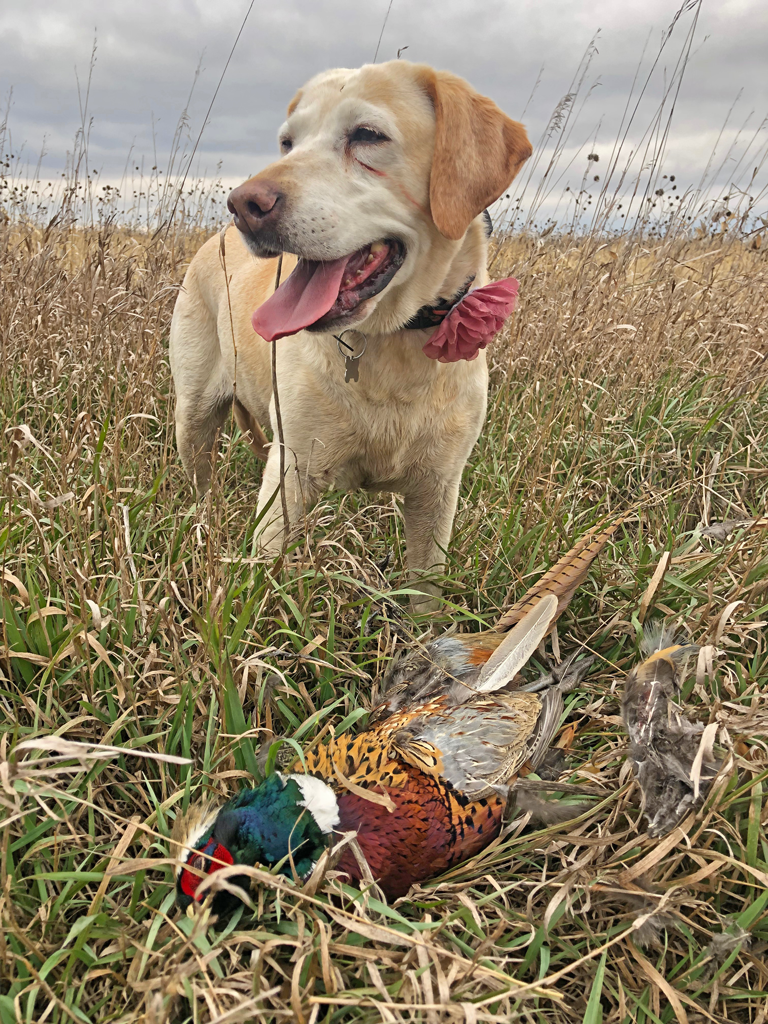 Folks who know me have heard me say this before, but for the record, I’ll say it again, for everybody. My dog, the yellow lab called Sandy, really got the shaft by having me in charge of her hunting schedule.
Folks who know me have heard me say this before, but for the record, I’ll say it again, for everybody. My dog, the yellow lab called Sandy, really got the shaft by having me in charge of her hunting schedule.
While most other hunting dogs are out in the field, chasing ducks or grouse or pheasants, she’s at home, waiting patiently for me to get back to the house after work. Some years, like last fall, she never even got to hunting once, nope, not a single time. So, you might imagine that whenever I do finally get a chance to take her hunting, it means a lot to me. I don’t know if it means as much to her, but in my heart and mind, I’d like to believe that it does.
My fishing season, like I wrote last week, ended on Wednesday. Thursday, I spent the day in Duluth with the Hippie Chick, learning about the details of her upcoming retirement. Then on Friday morning, our hunting adventure began! I packed a few days’ worth of sandwiches, a handful of shotgun shells, a bit of gear, one yellow dog and then hit the road.
The destination, Morris Minnesota, was only 4 hours from home, so we arrived in time to try a couple of spots. And as luck would have it, we got a pheasant at the first stop and I’m thinking, we’re off to a good start! Now, the wheels in my head are turning, and I’m thinking that we might still have time to get one more before dark. So, I say, “come on Sandy girl, lets squeeze in one more stop before we go to town and check into the motel.”
Sandy agreed eagerly with that plan, but my truck was not on the same page. When I started the engine, a yellow light on the dashboard said, “left rear tire pressure low, add air.” For a minute, I thought about taking my chances and stopping at another spot anyway, but my little voice said I’d be better off heading into town to get the problem sorted out.
Before I headed toward town, I “googled” for possibilities for tire repair and made a mental list. When I arrived at the first one, they were already closed, 4:15 on Friday, I guess they quit early for the weekend, I thought. So, I tried the 2nd place, closed and then the 3rd place, and before long, had wither found the stores closed, or had been told “NO” by everybody except one. That was the shop who generously offered to look at it, first thing on Monday morning. Hmm, it’s dark now, everybody’s closed, and my problem still isn’t solved.
Luckily, I found one gas station that actually still offers air, so I filled my tires there and hoped that I might get lucky, and that somehow, the tire would hold it's air overnight. I wasn’t that lucky though, on Saturday morning the tire was low again, almost flat. By now, I’ve “you tubed” all the self-help videos about how to locate my tools and swap out the flat with my spare tire. That did not help, none of them lead me to solve the mystery or where my tools were hidden away. So, I waited for daylight, limped into town, added more air to the leaky tire and began asking around for advice. The lady at the south side Cenex store was great, she offered guidance, made phone calls, did everything she could, but came up without help, and my problem still wasn’t solved.
Next, I tried the GM dealership, they were open, but refused to help, they were “too busy for me” their service man advised. He did agree, after some begging on my part, to at least show me where in the #$*& my tire tools were located. Now, that gave me the option to put on my spare, I thought. Instead, I learned that the cable holding the spare tire under the truck was rusted, and try as I might, that spare was never coming down; not without intervention.
 Okay, now it’s 9:45 on Saturday morning, I’ve been almost everywhere in town and been turned down cold. It was beginning to look like my dog was gonna get the shaft, again. But there was still one more place to try, the ford dealership called Valu Ford. Their parts man, working the service counter, Brennen Longnecker listened patiently while I described my problem and apparently, he was sympathetic. “Hold on a second’, Longnecker said, we only have one technician on duty today, but let me go talk to him and see if he can squeeze this in”. After a few minutes, he came back and told me that they could help. He advised me to pull my truck into the service bay. Sandy waited in the truck while their tech, Brett Moderow, found the offending chunk of metal, fixed my flat, and our hunting trip was saved!
Okay, now it’s 9:45 on Saturday morning, I’ve been almost everywhere in town and been turned down cold. It was beginning to look like my dog was gonna get the shaft, again. But there was still one more place to try, the ford dealership called Valu Ford. Their parts man, working the service counter, Brennen Longnecker listened patiently while I described my problem and apparently, he was sympathetic. “Hold on a second’, Longnecker said, we only have one technician on duty today, but let me go talk to him and see if he can squeeze this in”. After a few minutes, he came back and told me that they could help. He advised me to pull my truck into the service bay. Sandy waited in the truck while their tech, Brett Moderow, found the offending chunk of metal, fixed my flat, and our hunting trip was saved!
Before this trip, I’d never heard of Valu Ford, in Morris Minnesota, but I have now, and I will never forget them. Like everyone else in business, they are short staffed and overworked, Brennan and Brett could easily have made their door the last one to be slammed in my face on Saturday morning, but they didn’t. I'm sure taht the dealership didn’t make a lot of money on fixing my tire, not in cash at least. But if you put a "Valu" on good will; in that case they hit it big!
Now understand, the last time I ever owned a ford, it was back in high school and it was a 1963 Ford Econoline van, I've never had another Ford ever since. But whenever I’m looking for another truck, I’ll be considering a Ford again, because of their great service. I can’t really afford a truck now either, but if I could, I’d drive back down to Morris Minnesota right away, and I’d talk to the folks at Valu Ford.
Even if I'm not on the short list to be one of their next best customers, I’ll always appreciate them and how, in their infinite wisdom, they hired such great service people as Longnecker and Moderow. In the day and age when the words “no, sorry, and can’t help" roll off the tongue so easily, these guys remembered, YES isn’t such a bad word, especially when you're dealing with a customer in need. Thank you so much, I appreciate the help, and I'm sure my yellow lab does too, you saved her hunting trip!
I’ll bet you’re wondering if pheasant hunting was any good, and the answer to that is a shorter story. Two years ago, when I and Austin Jones hunted in that area, we were surprised by how many pheasants were there. But on this trip, I was amazed by how few of them were still hanging around. We covered a lot of ground, tried a lot of good-looking territory, and did a lot of walking, but only turned up a few birds. Truthfully, we did have some opportunities, and if my dog’s owner was a better shot, she could have come home maxed out, with her 3-day limit of 6 birds. For that to happen though, I would have needed to hit every single rooster that got up in front of me, and I’m just not that great of a shot these days.
That's okay, for me, the point of a hunting trip is not to harvest limits of birds anyway, it is to watch my dog, and experience her joy as she prances around in the field. So, in that sense, the trip was completely successful. Many of the birds she flushed on this trip were hens, and that jkept her busy. There were some roosters here and there too, and except for a couple of blank spots, she always found a little something to do. What was lucky is that the very last spot we tried was above average, that meant the trip ended with a grand finale’ of sorts and that was fun.
Locals probably do alright hunting in the Morris region, especially if they have access to private groud. For guys like me though, dependent on hunting public lands, I probably wouldn’t suggest chasing back down to hunt pheasants, at least not right now.
However, if you're anywhere close to the neighborhood, were in need of a Ford truck, or need to get your vehicle serviced, then I’d definitely suggest taking a trip to Morris’, where you might just be able to experience valuing the “Valu-Able” for yourself.
It's been cold for the past few days, and on my drive home, there were lots of small ditch ponds, and shallow water lakes frozen over. If the weather stays on it's present tracjectory, we might be talking ice fishing soon, so let's stay in touch! ![]() — Jeff Sundin 218-245-9858 or EMAIL
— Jeff Sundin 218-245-9858 or EMAIL
 Wired2Fish October 31, 2023 "Halloween Sale on Foldable Kayaks from Oru"
Wired2Fish October 31, 2023 "Halloween Sale on Foldable Kayaks from Oru"
 "Oru made a big splash at ICAST this summer with it’s foldable Kayak, and now their line of foldable “Black Series of Kayaks” are all on a massive Halloween Sale until Wednesday, Nov. 1, 2023.
"Oru made a big splash at ICAST this summer with it’s foldable Kayak, and now their line of foldable “Black Series of Kayaks” are all on a massive Halloween Sale until Wednesday, Nov. 1, 2023.
Oru Kayak is offering up to $500 off Black Kayaks and Black Kayak Bundles. This includes all Oru Kayak models in a sleek, black colorway. Some of the models are less than $500 now in this sale. So act now to get a cool packable kayak that sets up in minutes.
Dates: 10/30-11/1 Details: Up to $500 off Black Kayaks and ..." Learn More >> Halloween Sale on Foldable Kayaks from Oru
More Recent Fishing Reports
Sundin 10-31 • L.O.W 10-25 • Sundin 10-24 • Grand Rapids 10-23 • Sundin 10-22 • Sundin 10-21 • Winnibigoshish 10-20 • Crappie Report 10-18 • Lake Winnie 10-17 • L.O.W 10-17 • Crappies 10-16 • Winnie Walleyes 10-14 • Crappies 10-13 • Winnie 10-12 • Winnie Weeds 9-26 • Forward Sonar • Panfish Workgroup • Follow on Facebook
 Jeff Sundin October 26, 2023 "Pausing the Pause-Able"
Jeff Sundin October 26, 2023 "Pausing the Pause-Able"
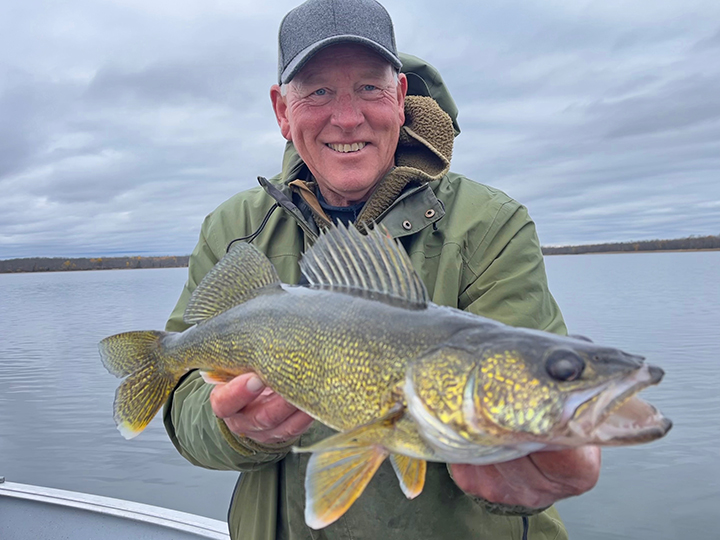 As I mentioned yesterday, my officially scheduled guide season has come to an end. Finishing the season without a “grand finale” because of that cancellation didn’t appeal much, so I and the Hippie Chick did carve out a few hours to wet a line together. While we were out there, the subject of me not wanting to be done for the season came up. What would it take for me to get comfortable with the idea of dry docking the boat for the winter? We speculated.
As I mentioned yesterday, my officially scheduled guide season has come to an end. Finishing the season without a “grand finale” because of that cancellation didn’t appeal much, so I and the Hippie Chick did carve out a few hours to wet a line together. While we were out there, the subject of me not wanting to be done for the season came up. What would it take for me to get comfortable with the idea of dry docking the boat for the winter? We speculated.
What might just work for that is a full week of overnight temps in the teens, combined with days where the daytime high temperatures never get out of the 30s. If a few raindrops and snowflakes came along with those temperatures, convincing me might even get easier. I still might not like it, but at least I wouldn’t get dragged away from the dock, kicking, and screaming!
Well folks, apparently Mother Nature is scheming to make that happen, and we could feel early signals of the incoming cold front slapping us in the face yesterday afternoon. Falling temperatures, and intermittent drops of rain chilled our hands, surface water temperatures began chilling too, dropping below 52 degrees for the first time in a couple of weeks. That was just the beginning, it appears. Today’s forecast of rain, combined with a high temperature of 43 degrees sounds cold enough, but will be the nicest day we will experience for a while. Air temperatures begin falling tonight, and continue getting colder every day for a week, maybe longer.
So, today is the day, I guess, that Cub Reporter, Staff #003, IHBFBB must humbly report, that there’s nothing left to report, for a little while. I’m going to freeze the last of my minnows, drain the water out of everything that’s drainable, and put the boat into “semi-retirement” for a while.
For everybody who shared the boat with me this season, and everyone who followed our stories and reports on these pages, all I can say is thank you! I am truly blessed to have your support and friendships. To me, you are all part of my family, and I hope you feel that way too.
Don’t worry, I’ll still be posting news about folks that are still on the lakes, and soon, we’ll be talking about the ice fishing season. In the meantime, I’m going to wake up a little bit later, take life a little less seriously and starting tomorrow, take my dog for a walk. See you soon! ![]() — Jeff Sundin 218-245-9858 or EMAIL
— Jeff Sundin 218-245-9858 or EMAIL
 Lake of the Woods, LOW Tourism October 25, 2023
Lake of the Woods, LOW Tourism October 25, 2023
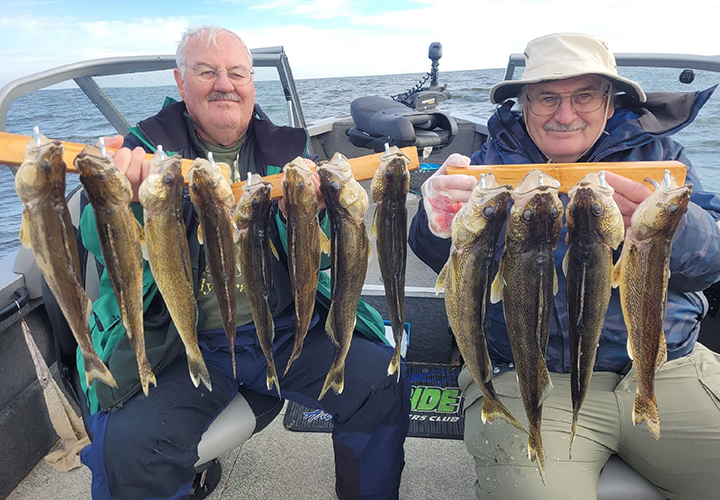 "There has been a very strong bite along the south shore of Lake of the Woods. Nice numbers of walleyes and saugers are targeting big schools of emerald shiners in the lake. The target depth is 26 feet of water, give or take, with nice limits being caught from Pine Island, Morris Point, Zippel Bay and Long Point. As is the norm on Lake of the Woods, a mixed bag with pike, jumbo perch, sturgeon, crappies and smallmouth bass in the mix as well.
"There has been a very strong bite along the south shore of Lake of the Woods. Nice numbers of walleyes and saugers are targeting big schools of emerald shiners in the lake. The target depth is 26 feet of water, give or take, with nice limits being caught from Pine Island, Morris Point, Zippel Bay and Long Point. As is the norm on Lake of the Woods, a mixed bag with pike, jumbo perch, sturgeon, crappies and smallmouth bass in the mix as well.
Most anglers are jigging with an emerald shiner, rainbow or fathead. Jig colors of gold, pink, orange, glow white and red or a combo of those colors have been consistent. Some anglers are still trolling lead core and catching walleyes and saugers, but most anglers are jigging with great success.
On the Rainy River, shiners continue to run into the Rainy River, and to nobody's surprise, walleye fishing continues to get better and better. Most fish so far have been nice eater fish with small fish mixed in. Those targeting big walleyes are hoping the deer hunting tradition of putting out big fish continues.
Two methods are catching most of the walleyes. Jigging with emerald shiners and trolling crankbaits with lead core line or 3 way rigs are both catching walleyes. Jigging produced nice eater walleyes this week. Target depths range from 8 to 24 feet of water, depending upon what part of the river you are fishing.
Up at the Northwest Angle, walleye fishing is strong on both sides of the border up at the Angle. Points, reefs, flats and neck down areas with current in 17 to 22 feet continue to hold good numbers of walleyes and anglers are reporting big numbers of fish. Most anglers are catching fish jigging primarily. Pike, smallmouth bass, jumbo perch, crappies and muskies have been active as well." — Lake of the Woods Tourism, (800) 382-FISH
 Jeff Sundin October 24, 2023 "The Unwanted Unwind"
Jeff Sundin October 24, 2023 "The Unwanted Unwind"
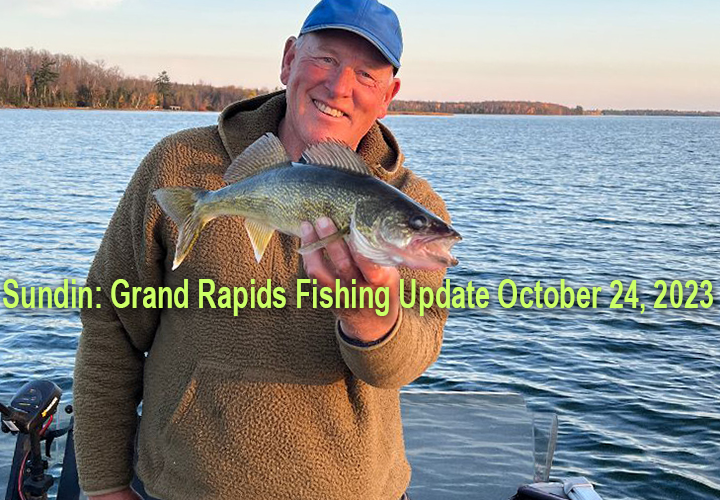 "Yesterday, while we floated on calm water, under a clear sky, and on a warm evening, I told Mrs. Sundin. “No matter how much I look forward to a change of scenery, letting go of the fishing season isn’t going to be easy, I am not ready to be finished”. “If it was windy, 35 degrees and snowing, you wouldn’t be saying that”, Susan said.
"Yesterday, while we floated on calm water, under a clear sky, and on a warm evening, I told Mrs. Sundin. “No matter how much I look forward to a change of scenery, letting go of the fishing season isn’t going to be easy, I am not ready to be finished”. “If it was windy, 35 degrees and snowing, you wouldn’t be saying that”, Susan said.
Well, even if it was miserable outside, I’m still not sure that I’d be ready for the end of the season, but it’s not, it’s beautiful. And if that’s not bad enough, the fish are still biting too, not just in a few lakes, but in a lot of them. And if that’s not bad enough, my last day, Wednesday, is going to end with a cancellation! That’s right, instead of wrapping the season on a high note, returning home rewarded for a job well done, I’ll be washing the boat or changing the oil or some other form of toil. Oh well, maybe I’ll get lucky, and the wind will be blowing, and it will be 35 degrees and it will be snowing; that would help me feel better a little bit.
Until it’s over though, it’s not over, there are still a lot of folks out on the lakes and some of them are sharing reports with me, here are a few of them.
With water temperatures holding steady in the 53-to-55-degree range, walleyes, especially larger fish, in the Grand Rapids area’s deeper, clear water lakes are on the prowl. The action doesn’t last all day long, but for folks who fish early, or late in the day, the bite is reliable.
Large minnows combined with live bait rigs produce the best results. Creek chubs, redtails or even larger size golden shiners will work, size it the important part; 6-to-8-inch minnows are ideal. Finding them in the region may be tricky, but not impossible. A friend tipped me off last night that the River Rat Bait shop had some on hand this week. Fred’s Bait, Deer River, closed for the season after the weekend, but the Winnie One Stop, near Winnie Dam remains open and might also be an option, but I’d call ahead, just to be safe.
Winnie walleyes haven’t given up on their fall feeding runs either. Just this morning, I got an email note from Jim Atkinson who wrote, “Hi jeff, thought I'd share today's (Monday 10-23) trip to Winnie. We put in on the south end as the wind was blowing briskly from the southeast. We headed toward the northwest corner but turned back about halfway as waves started coming over the bow of the Ranger.
We ended up in the southwest where it wasn't so rough. As luck would have it we found some good schools of walleyes in 6 to 7 feet. It was probably one of the best Fall days of fishing I've ever had.
Thanks for all your reports as you inspired us to give it one last shot. Winne has gotten the better of me more than once, but today was a win for the home team. Thanks again for all the info you share. If we can't be there in person, we can fish vicariously thru you. Keep up the good work!
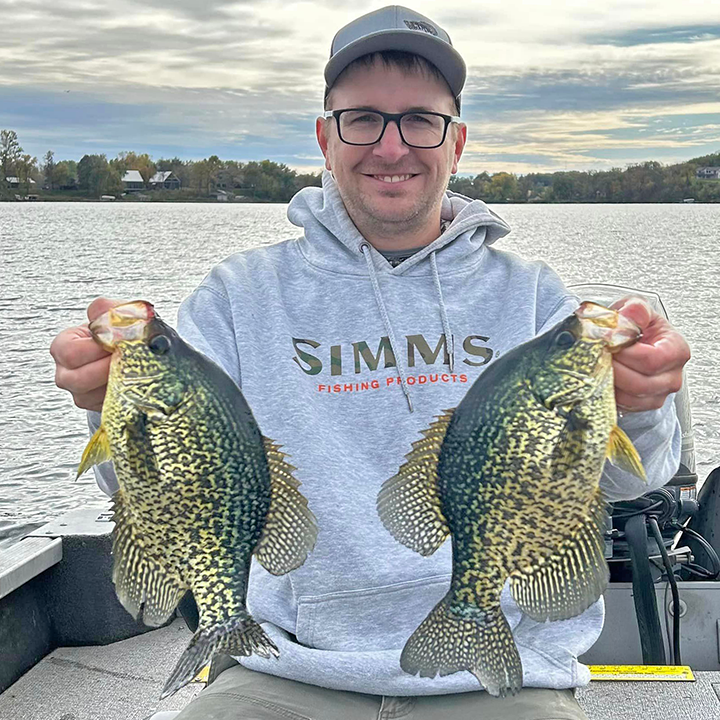 Crappie fishing is going better on some lakes than it is on others, but for creative anglers like Trevor Olson, it’s going great. I spied the photos, originally shared on one of the social pages and I asked Olson for permission to share, and he agreed. Without sharing any of his secrets, I can tell you that he found the school of good ones, suspended over a mid-lake basin.
Crappie fishing is going better on some lakes than it is on others, but for creative anglers like Trevor Olson, it’s going great. I spied the photos, originally shared on one of the social pages and I asked Olson for permission to share, and he agreed. Without sharing any of his secrets, I can tell you that he found the school of good ones, suspended over a mid-lake basin.
Over the past few seasons, I’ve mentioned following the huge schools of 2018 year class crappies around lakes in my region. By now, you’ve likely discovered some of those lakes on your own, and if you’re looking for eaters, that’s where you should go. If you aspire to be like Olson though, and want to find large fish, then you will be better off looking for them in lakes with lower populations. Whenever you hear phrases like “that lake has crappies, but they’re not easy to find”, or “they’re in there and when you find them, they’re big”; then you’ll know you’re on the right track.
Perch fishing got a lot of press attention a few weeks ago, then sort of fell off the front page. They’re still biting though and folks on Leech Lake, Cass Lake and Winnie are finding them. When the wind blows, and the skies are grey, it is go time in shallow water. Shoreline breaks, shallow water rock bars and patches of weeds like Wild Celery are the best areas to look. When it’s calm. Skip the perch and check out some of the panfish, northern pike or bass spots instead.
With the full moon coming, large pike and muskies will be on the radar screens of die-hard toothy critter chasers. Tullibees, the main forage for huge fish will be in shallow water on their fall spawning runs. Often a catalyst for seasonal change, the full moon is likely to heighten the fish’ senses about moving in to feed on them. Late evening and after dark are best, but some fish will always be active during the day. Key areas are shallow flats that contain rocks and gravel patches and are located adjacent to deeper water. Tullibee will spend daylight hours suspended over the deeper water, then move into the shallows to spawn after dark.
I’ll be on duty for a couple more days, but like I said, after today my season ends unexpectedly. Then I’m going to take my dog for a nice long walk in the woods for a few days and with luck, she’ll get her fill of tasting tail feathers. If you’re still on the lakes, I hope you’ll pass along a few notes to assist your fellow anglers! ![]() — Jeff Sundin 218-245-9858 or EMAIL
— Jeff Sundin 218-245-9858 or EMAIL
 Jeff Sundin October 23, 2023 "Grab Bag of Grab-Able Goodies"
Jeff Sundin October 23, 2023 "Grab Bag of Grab-Able Goodies"
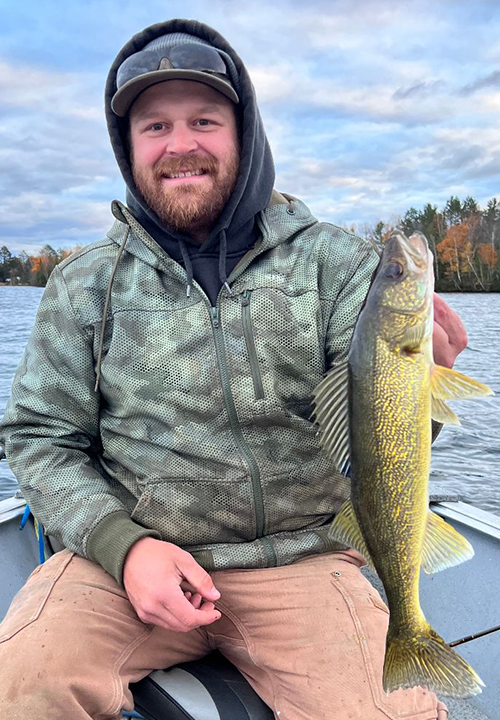 It’s been a while since I and the Hippie Chick had a chance to fish with our daughter Joelle, and her fiancé Patrick. But finally saw the chance to steal a couple of hours for a quick evening trip, and we took it.
It’s been a while since I and the Hippie Chick had a chance to fish with our daughter Joelle, and her fiancé Patrick. But finally saw the chance to steal a couple of hours for a quick evening trip, and we took it.
The lake Susan and I usually visit once each season is a small, a little over 500 acres, multi-species lake. We ordinarily fish together there on the Labor Day weekend when all the fish are still on the weedline, but have missed going there for a couple of years.
Usually, we fish using wiggle worms, and catch some bass, sunfish, and pike early in the day. Then we catch walleyes as the sun goes down; sometimes we do well, other times we just get a few. For today, I would have been happy to find crappies instead, but had no idea where they’d be, so we arrived an hour earlier than the kids, and used the time to search for fish, beforehand.
At the ramp, the surface water temperature was 53 degrees, and that didn’t change much anyplace on the lake. The skies were mixed, clouds, sunshine, sprinkles, and the breezes were stiff, from the northwest at 15 to 20 MPH. If there was time, I hoped to have found fish along the shoreline breaks, but we were able to troll around about 2/3 of the perimeter without spotting anything there. As I moved deeper, I spotted the first school of fish at about 41 feet deep, then another one at 45 feet and eventually, another school, suspended over 70 feet. All those fish were too deep, so we never dropped a line in the water.
We looked at one last spot, a small depression in one of the weedy bays. The water depth was 16 feet, and the side imaging showed a couple of schools of what I believed might be sunfish. We didn’t have time to fish for them, but I would have been happy to have them as a backup plan, and made note of the spot and headed for the dock.
Because I hadn’t really developed a game plan, the first thing we did after picking the kids up at the dock, was to go back to the basics and slow troll along the weed edges. As I headed toward one of our favorite spots, I spotted some more fish in deep water, this time they looked more like walleyes, but they were still too deep to fish, so we passed them by. I made note of them though, because I thought they might move shallower as the sun set later.
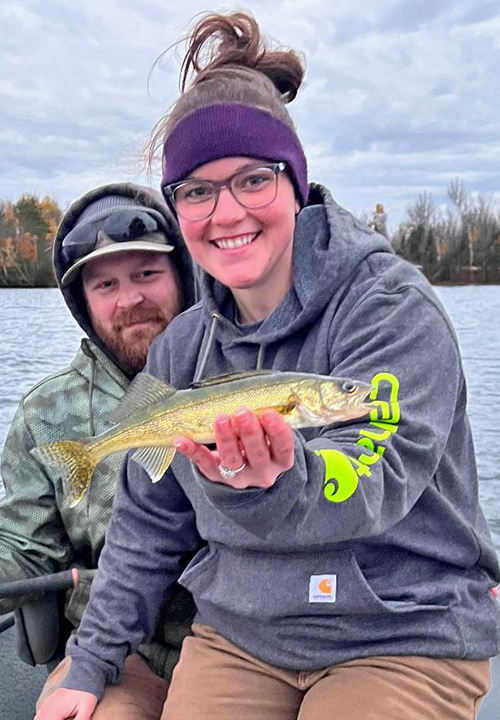 I offered everyone the choice between 2 presentations, wiggle worming or jig and minnows. I and the girls chose night crawlers, Patrick chose minnows. At our preferred point, Pat caught a decent size northern pike, other than that, not much happened. So, we moved over to another, larger point located adjacent to a weedy flat. Here, it appeared that wiggle worming was going to emerge as the preferred pattern. Both I and Susan had been feeding lines to fish, but neither of those fish got hooked. Then I caught a largemouth bass, and Parick caught the first nice walleye on a jig and minnow. The next few fish were small, but Pat was catching enough walleyes on minnows to induce the rest of us to switch baits.
I offered everyone the choice between 2 presentations, wiggle worming or jig and minnows. I and the girls chose night crawlers, Patrick chose minnows. At our preferred point, Pat caught a decent size northern pike, other than that, not much happened. So, we moved over to another, larger point located adjacent to a weedy flat. Here, it appeared that wiggle worming was going to emerge as the preferred pattern. Both I and Susan had been feeding lines to fish, but neither of those fish got hooked. Then I caught a largemouth bass, and Parick caught the first nice walleye on a jig and minnow. The next few fish were small, but Pat was catching enough walleyes on minnows to induce the rest of us to switch baits.
By now, it is getting dark, our time is limited, but I’m curious about those fish I saw earlier. What if they moved out of the deep hole, and up onto the point where we like to fish? We moved over there, set up shop in about 18 feet of water, and discovered that some of those fish had moved onto it. Patrick caught another “keeper” size walleye, and the rest of us each released a small one. By now, it’s dark and food has become the new priority; so, we headed home.
For folks hoping to get some “hard core” fishing news from today’s report, let’s expand on this theme. From here on out, 2 or 3 hours on a lake will be all anybody really “needs” to fish. Sure, you can still fish all day long if you like, but the evening run that my family enjoyed will occur on almost every decent walleye lake in the region. I have friends that have been following this pattern for a couple of weeks already and for the most part, are catching good numbers of fish every evening.
Jig and minnow presentations will still work for catching numbers of fish, but there’s an opportunity to single out large fish by switching presentations. In the good old days, Bob Carlson, “Mr. C” and his son Mike used to love fishing with me during late fall. In fact, they were typically my last charter of each season and when we fished, catching big walleyes was always the goal.
The big walleye pattern, fishing shoreline related points that lie adjacent to deep water, works best when you fish with large minnows. For me, a live bait rig using a 1/0 or 2/0 bait hook, tied on a 6-foot leader made of14 to 27-pound fluorocarbon works well. Large minnows, like redtails, creek chubs or super-sized golden shiners all work. They need to be big, 6 to 8 inches long, and they need to be lively. We hook the minnows lightly to the upper lip, this allows them to draw water and allows them to stay lively for a long time.
Key depths are usually 18 to 22 feet, but this varies with the structure that’s available in your lake. You can usually figure out which structures to focus on because you’ll see fish holding in the adjacent deeper holes. For me, there’s little temptation to fish for the deep fish, because they don’t become active until they move up onto the structures.
No Jeff, I’d rather just go out and try to catch some eaters, you’re thinking. Okay then, during the weekend, Winnie’s walleye bite continued to hang in there too. The robust MEA weekend crowds were still on the lake, but instead of floating on a flat calm surface, they were bouncing in the waves. As expected, the breezy weather encouraged walleyes to feed more heavily and some folks who’d been struggling last Friday, made up for lost time on Saturday and Sunday.
The report I got from my customers, Tom and Brad, who I fished with last Friday, offered proof and was also typical of reports I’d received from others. “We fished the north shore yesterday, and then moved over to Third River. (We fished) off the point, circling the area in 8 to 10 feet of water and caught 15 plus walleyes in the 15-to-17-inch size range. Brad caught a couple of walleyes over 18 inches yesterday too, the weather conditions were perfect for walleye fishing.” Tom wrote. Tom mentioned too that where they fished, the crowds got a little intense. I think that with the passing of the MEA weekend, they’ll be more manageable from here on out.
I’m fishing on borrowed time right now. I still have a couple of fishing days scheduled, but soon, the rest of my life will begin taking over. Honey dos, repairs, and maintenance, and hopefully, hunting with my dog will soon reach the top of my list. I’ll be providing updates as they become available, so don’t give up on me yet. And today, before I wrap up for the morning, let me clean up some more reader comments and questions.
 10-23-2023 Frank Jeffries wrote,
10-23-2023 Frank Jeffries wrote,
“Hey Jeff, I love all your reports, but the ones I really love most are when you share personal stories about your customers. I’ll bet they like re-living their fishing experiences through your eyes. I can’t help but wonder though, what’s your story, do you really love fishing as much as it appears, or is this just a job that you do well? And when you go fishing for yourself, do you fish for the same fish, or do you have a personal favorite?
A) Frank, thanks for the note and thank you too for the compliments. I do think you’re right, most folks like seeing the reports about their own fishing trips. Your first question, as it happens, is the entire reason that I write them in that way.
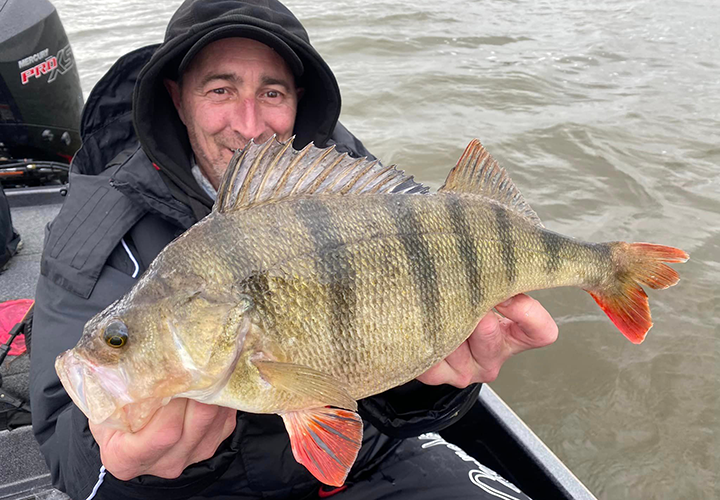 Fishing, as fun as it is, can never be the singular reason why a fishing guide is happy doing their job, at least that’s my opinion. What I really love are people, they fascinate me, and they offer knowledge, and when we connect, most of them return my love for them, with an equal to or greater than love for me. So, yes, most days, I do really love my job, and the answer to your second question is the reason that there are ever any days that I don’t love it.
Fishing, as fun as it is, can never be the singular reason why a fishing guide is happy doing their job, at least that’s my opinion. What I really love are people, they fascinate me, and they offer knowledge, and when we connect, most of them return my love for them, with an equal to or greater than love for me. So, yes, most days, I do really love my job, and the answer to your second question is the reason that there are ever any days that I don’t love it.
Walleyes, as fun as they are to catch, are not always the most fun fish to target. Sometimes, catching them is the only thing that will make certain people happy and when that certain person wants walleyes on a day that the walleyes don’t want to be caught, it can turn into a grind. I’m a natural born panfish angler, it’s what I did growing up and if I fish on a day off, likely what I’ll be pursuing. Sunfish, in my region, would have to top my list of all time favorites.
If I had the means, and the time to travel, catching a couple European “Super Perch” would surely rank high on my bucket list too. The accompanying photo, provided with permission by Willem Stolk, a facebook friend, is what I’m talking about. The perch, caught in the Netherlands is almost the same fish as the perch we catch here in Minnesota, except that they’re a lot bigger. I can only imagine how much fun it would be to reel in a perch that’s weighed in pounds, rather than ounces.
 10-23-2023 Paul Plinske wrote;
10-23-2023 Paul Plinske wrote;
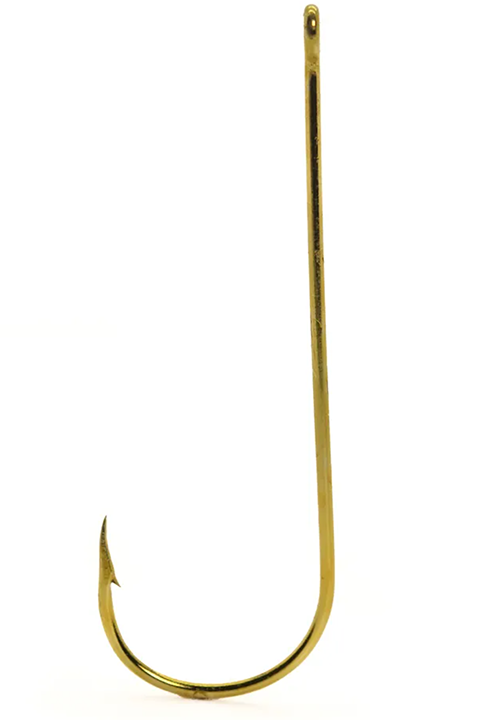 “Jeff, I have read (that) you tie your own walleye spinners, as I assume many guides do. I also enjoy tying my own single hook spinners. However, I am having g trouble finding a hook I like. I try to have my components mirror the little Joe as much as possible. What brand, style and hook size have you found that works for your minnow presentations?”
“Jeff, I have read (that) you tie your own walleye spinners, as I assume many guides do. I also enjoy tying my own single hook spinners. However, I am having g trouble finding a hook I like. I try to have my components mirror the little Joe as much as possible. What brand, style and hook size have you found that works for your minnow presentations?”
A) Paul, for a long time I was completely content with the standard spinners sold by Little Joe. It wasn’t until they discontinued offering plated blades, substituting painted ones instead. For me, the flashy blade is the whole point of using spinners, and the flashier they are, the better they work.
Spinner blades aside, the 2/0 Aberdeen hooks that Little Joe offers have always worked great for me. Now the hooks I use, Mustad’s 37363, 2/0 Aberdeen Gold are very close, if not identical to the ones Little Joe sells. These are light wire hooks, so they are lighter in weight than some of the heavier alternatives on the market. The included link should take you to Mustad’s website, where you can purchase them at reasonable process.
 19-23-2023 In response to yesterday’s (10-22-23) Q&A TR James wrote,
19-23-2023 In response to yesterday’s (10-22-23) Q&A TR James wrote,
“Hi Jeff, Thanks for your latest article about barotrauma. Your assumptions about my life are completely wrong, much like your assumption that most of those crappies that swim away are going to make it. Who's to know, it's an assumption.
Based on your writing from last year, I assumed you were now going to stick with urging you readers to catch and kill when fishing deep water. My assumption was wrong - I didn't expect you to encourage "tricks". Anyway, you wrote a timely article about barotrauma, so that's a plus.” -TR
Mr. James, Yes, That's the way I'd imagined you'd respond.
 Reader Comments October 22, 2023 TR James: "Jeff Sundin; You Should Be Ashamed!"
Reader Comments October 22, 2023 TR James: "Jeff Sundin; You Should Be Ashamed!"
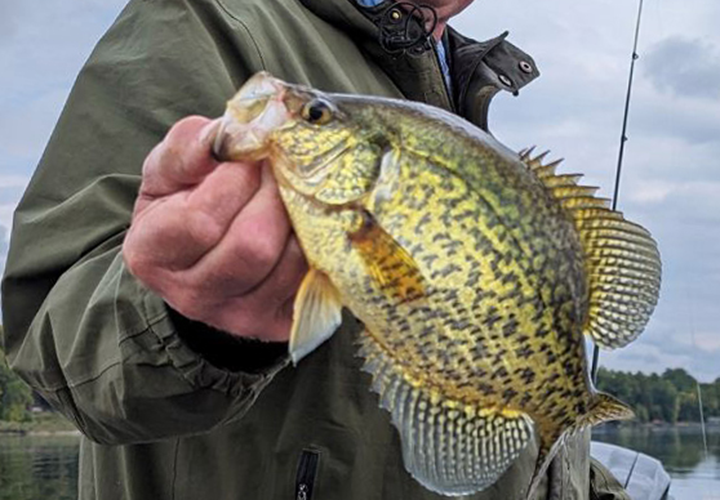 Last Thursday, TR James Emailed, "Very disappointed that you are back to fishing deep water to get limits of keeper crappies for your clients. AND, even more disappointed to see you putting out "tricks" for others to to use in their justification of same. 20 feet is deep, 25 is too deep - you know that. You, as a newly inducted Hall of Famer should be ashamed." - TR James
Last Thursday, TR James Emailed, "Very disappointed that you are back to fishing deep water to get limits of keeper crappies for your clients. AND, even more disappointed to see you putting out "tricks" for others to to use in their justification of same. 20 feet is deep, 25 is too deep - you know that. You, as a newly inducted Hall of Famer should be ashamed." - TR James
Mr. James, Congratulations on living a life free of “grey area”, one where everything is viewed in either black or white. I hope to join you there someday, but for now, I’m beholding people. More specifically, folks who pay me to assist them in the pursuit of their dreams, not mine. Striking a balance between “ideal fishing scenarios”, and less than idea ones isn’t always easy. On occasion, I need to figure out the best way to compromise between the two. The fishing report you referred to, (October 18, 2023) lays out in detail the events that led to one of these compromises. It was, on that day, the best balance between fulfilling the needs of my customers, while at the same time, minimizing the impact to that particular fishery.
If there’s any subject in all of fishing shrouded in more “grey fabric” than barotrauma, I’ve yet to figure out what it is. However, there is one absolute, and I want to be crystal clear about this fact. Barotrauma, and any negative impact it has on a fish's health is an issue strictly associated with catch and release fishing. If any angler’s goal is to harvest their legal limit of crappies, or other fish, whatever that number may be, and they’re willing to capture the first several fish they catch to achieve it, then it matters not which depth those fish are caught. It is only when an anglers intention is to release a portion of those fish that barotrauma must be considered.
From my October 18, 2023 report, “I’d fished the lake once this summer and knew the average size crappies. I figured that most of the fish we could catch would be “keepers”, so even if we fished in the deepest water, the risk of barotrauma would be manageable.” In other words, I calculated that most of the fish we caught would be of harvestable size.
Further down the page I wrote, “Yesterday, 26 feet of water was the magic number, at 25 feet the screen went blank, and at 27 feet, it went blank again.”
In your opinion, anything deeper than 25 feet of water is too deep, and in certain cases, I’d agree. But there are mitigating factors to consider, such as where they are suspended in the water column and the length of time they've been holding there, for example. There are other mitigating factors too, and they’ll be the subject of future articles. On this occasion though, most of the fish we caught were harvested anyway, so we were not concerned. There were a few fish that we released, and when we did, we used a trick, blowing in their mouths to ensure that they swam away fast and clean.
In your opinion, I should not have shared that tip with readers. But I’ll offer this, if everybody who fishes for panfish in cold water, no matter how deep, does this, there will be a significant number lives saved. I can’t offer any precise ratio, but there is no doubt in my mind that it works.In fact, I’m so convinced about it that I insist that every customer on every trip follows the practice any time we release any panfish in the fall.
In my account of the fishing trip, I offered this too, “I agreed to keep 5 of the smaller fish, allowing the crew to have their limits on larger ones. The extra 5, the ones I could have harvested, but didn’t, were counted in my imaginary bag limit.” So, on the off chance that we did unintentionally kill any crappies, they were counted as if they’d been harvested."
In your opinion, I should be ashamed of myself for engaging with the crappies on this lake, in those water depths, under these circumstances, and on this day. Without doubt, you are entitled to hold that opinion, and I apologize for being a disappointment to you. However, I was having trouble seeing it your way and it bothered me. So, I shared the comments with my fellow members of the MN DNR Panfish Workgroup and asked them if they believed I was off base in the way I handled the fishing scenario on this trip. I’m afraid the folks who responded had trouble seeing it your way too.
One of them mentioned that after reading the report, he’d gotten the impression that I’d already looked for these fish everyplace else on that lake before fishing for them at the mid-lake basin. It was true, I did look for every other alternative and it was only after those efforts failed that I took Mother Nature’s, less than ideal compromise.
Jeff Reed, co-chair of the Panfish Workgroup wrote, “The timing of this is interesting. We are putting together some outreach materials and were debating whether we should start with 20 or 25 feet as depths for anglers to start watching for symptoms. We had low mortality at 20 feet, and it didn’t really get much higher until 28 plus. So that makes wonder if there is some difference between fall and winter, that perhaps these fall fish are more susceptible because they’ve just recently moved deeper. Something we might need to look into.
As for your ‘ethical’ conundrum, I see harvesting those fish and then moving to a different area or species is exactly what anglers wanting to fish for an entire day should do; you could have sat in those fish all day and caught and released fish. So, I think your critic was a bit harsh.”
I’m guessing my response probably won’t be satisfactory to you, but I’m going to close with one more fact. Most Minnesota anglers, including me, had never even heard of barotrauma 10 years ago. I began writing about it then, when an acquaintance, Bob Mehsikomer shared information about catching a northern pike in deep water with me. It was his words of warning that alerted me to the subject and I took them to heart. Since then, I’ve been at the forefront of writers covering the topic, offering numerous articles and advisories like this one, >> "How Barotrauma Affects Released Fish — What We Don’t Know Might Kill Them". Today, there is widespread interest in learning more about barotrauma, including a cooperative MN DNR/Lindner Media study launched last winter.
I can’t begin to estimate how many fish have already been saved because of my writings and the subsequent attention this subject has received. I do know though that it’s more than enough for me to hold my head high whenever the subject is brought up.
I apologize again for disappointing you, and for not living up to the elevated standard you’ve set for me. Today, I’ll go back to selecting crappie fishing spots based on my preferred shallow water lakes profile. But I can’t promise that I’ll never find myself outside of my home territory again. If I find myself needing to make a compromise with Mother Nature again, I’ll do my best to make it a reasonable one. ![]() — Jeff Sundin 218-245-9858 or EMAIL
— Jeff Sundin 218-245-9858 or EMAIL
 Jeff Sundin October 18, 2023 "Last Chance Look at the Crappie Hole"
Jeff Sundin October 18, 2023 "Last Chance Look at the Crappie Hole"
 There’s no way that any one person can know everything that’s going on at any of Minnesota’s larger lakes. So too, knowing what’s happening in any given region is even less likely, and keeping tabs on the whole state; impossible! That’s why I, Cub Reporter, Staff #003 IHBFBB, continually offer readers the opportunity to contribute fishing tips that might help their fellow anglers enjoy the time they have to spend fishing. It doesn’t happen as often as I’d like, but it does happen, and this week, reader contributions produced results that I am really proud of!
There’s no way that any one person can know everything that’s going on at any of Minnesota’s larger lakes. So too, knowing what’s happening in any given region is even less likely, and keeping tabs on the whole state; impossible! That’s why I, Cub Reporter, Staff #003 IHBFBB, continually offer readers the opportunity to contribute fishing tips that might help their fellow anglers enjoy the time they have to spend fishing. It doesn’t happen as often as I’d like, but it does happen, and this week, reader contributions produced results that I am really proud of!
I may be able to share a few of those testimonials provided that I have time to get with everybody and arrange for their permission. But before we get to that, let me share with you how one of those reader contributions helped Mr. Bill and his son, Matt Fromelt, my fishing customers, get in on a really “crappie” experience yesterday.
I wrote yesterday that the Fromelts already had walleyes from the trip to Winnie this past Monday, and that on Tuesday, we’d be searching for crappies. After considering the logistics for a suitable meeting place, I sorted through ideas about lakes that were reasonably close to their cabin and then came up with a short list. There were 4 or 5 lakes that could have worked, so I decided to start with the closest one first, then move to another one if needed.
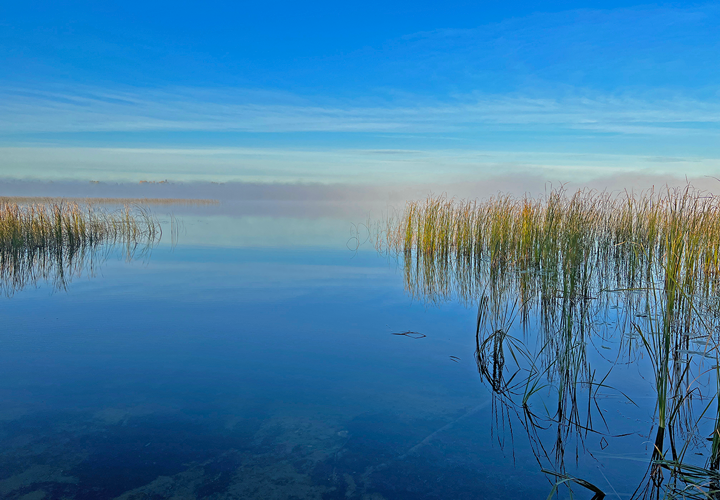 The lake I chose was a good fit for my profile of an ideal fall crappie fishing lake. The size, 491 acres is manageable, I can scan the entire lake in a few hours. The structure is simple, there are weedy shoreline flats around the entire perimeter and only one mid-lake hole. The maximum depth of that mid-lake basin, 29 feet of water is a hair deep for me, but I’d fished the lake once this summer and knew the average size crappies. I figured that most of the fish we could catch would be “keepers”, so even if we fished in the deepest water, the risk of barotrauma would be manageable. Besides, the crappies we caught on my past few trips have been shallower, spread out across the flats in 16 to 22 feet.
The lake I chose was a good fit for my profile of an ideal fall crappie fishing lake. The size, 491 acres is manageable, I can scan the entire lake in a few hours. The structure is simple, there are weedy shoreline flats around the entire perimeter and only one mid-lake hole. The maximum depth of that mid-lake basin, 29 feet of water is a hair deep for me, but I’d fished the lake once this summer and knew the average size crappies. I figured that most of the fish we could catch would be “keepers”, so even if we fished in the deepest water, the risk of barotrauma would be manageable. Besides, the crappies we caught on my past few trips have been shallower, spread out across the flats in 16 to 22 feet.
When we left the landing, the air was crisp and the surface water was 48 degrees. As we moved deeper into the center, 51 to 52 degrees was the average. Even though I had the mid-depth flats fishing strategy in mind, I knew that I better check “the hole” before doing anything else. I scanned the whole thing, traveled through the center, and then scanned around the edges. My side imaging did pick up one small pack of fish, but when we tried them, they turned out to be perch in the 4-to-5-inch size range.
Okay, well they must be on the flats then, I thought and started roaming with the side imaging again. I didn’t see much, but there were a few marks tight to the bottom, so we tried to find crappies there, but again, found only small sized perch.
Okay, well they must still be on the weed edges then, that’s where they were on my other trip, I’ll look there, I thought. When we started working the weed edges, the boys stuck with crappie baits. I figured that a night crawler might help me locate some sunfish, and they’d be a suitable alternative to crappies. I saw some fish in the weeds, but the only ones we caught were a couple of pike, a few walleyes and again, numerous small sized perch.
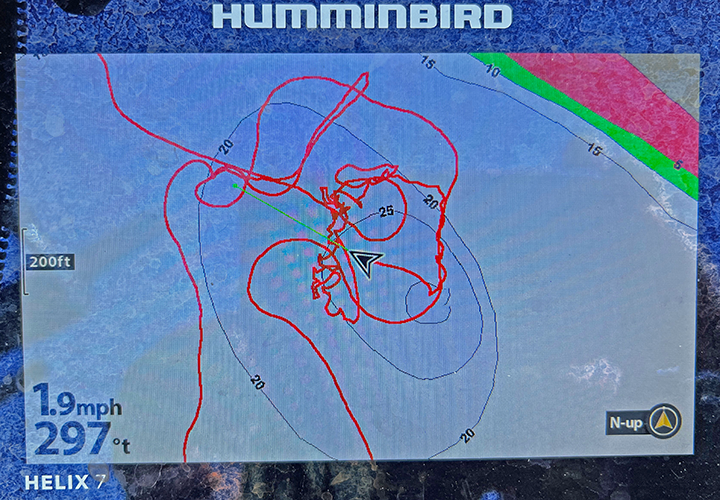 By now, it was 11:30 and I was preparing to make a move to the next lake. But remembering an email that came in on Monday, the gist of which was that the reader had found fish spread out over the flats one day, but the next day found that they’d moved, locating them this time in deeper water. So, before loading up and moving out, I decided to take one more look at the deeper hole. When I returned to it, my screen looked different, this time it revealed some fish and so the least I could do was give the spot a try. I’m guessing that it took Mr. Bill about 14 seconds to hook the first fish, and it turned out to be a keeper crappie. Not long afterward, I caught one then Bill caught another one and then Matt started giggling and then, we poked around that hole until the larder was filled.
By now, it was 11:30 and I was preparing to make a move to the next lake. But remembering an email that came in on Monday, the gist of which was that the reader had found fish spread out over the flats one day, but the next day found that they’d moved, locating them this time in deeper water. So, before loading up and moving out, I decided to take one more look at the deeper hole. When I returned to it, my screen looked different, this time it revealed some fish and so the least I could do was give the spot a try. I’m guessing that it took Mr. Bill about 14 seconds to hook the first fish, and it turned out to be a keeper crappie. Not long afterward, I caught one then Bill caught another one and then Matt started giggling and then, we poked around that hole until the larder was filled.
Look at my plotter trail on the chart, you can see the pattern or where crappies here are holding. They were around the outer edge of the hole, not in the center and not on the flat either; they were holding tight to the breakline. Yesterday, 26 feet of water was the magic number, at 25 feet the screen went blank, and at 27 feet, it went blank again. The fish were not tightly schooled either, there were packs of fish that were grouped by size. When I spotted larger schools of fish, we caught small ones, and typically that was all we caught. Larger fish were in smaller packs, and when I started skipping over the larger packs and focusing on singles or doubles; the action was slower but produced nicer fish.
Our presentation was nothing fancy, Bill stuck with an 1/8-ounce Live Bait Jig and small minnow. I used a tungsten ice worm tipped with a Bobby Garland Mo Glo and Matt was dropping in a live bait jig tipped with a plastic he called a nymph. To me, it looked a lot like the old Puddle Jumpers, and I’ll bet those would have worked fine too.
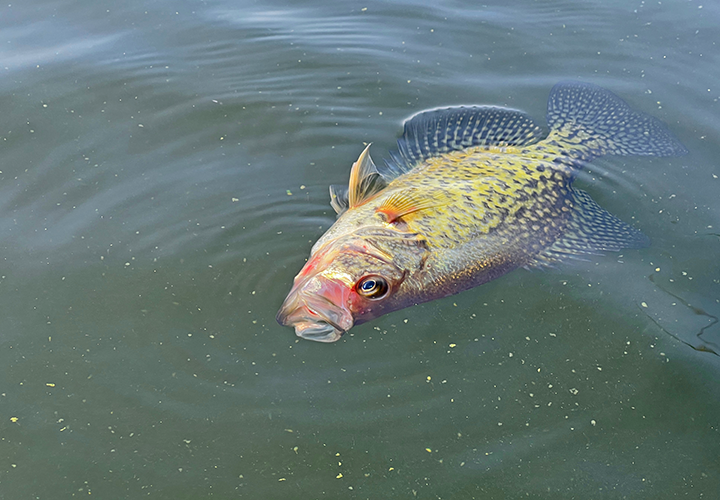 Luckily, most of the fish we caught were nice enough, 11 to 12 inches, to be harvested. Because even though we were not fishing in super deep water, barotrauma did become an issue. Blowing in the fish’s mouth, the trick I shared last week for helping release fish worked most of the time, but not always. Throughout the day, there were temptations to sort out only the largest crappies, but we had to keep some smaller fish that could not be revived. I agreed to keep 5 of the smaller fish, allowing the crew to have their limits on larger ones. The extra 5, the ones I could have harvested, but didn’t, were counted in my imaginary bag limit.
Luckily, most of the fish we caught were nice enough, 11 to 12 inches, to be harvested. Because even though we were not fishing in super deep water, barotrauma did become an issue. Blowing in the fish’s mouth, the trick I shared last week for helping release fish worked most of the time, but not always. Throughout the day, there were temptations to sort out only the largest crappies, but we had to keep some smaller fish that could not be revived. I agreed to keep 5 of the smaller fish, allowing the crew to have their limits on larger ones. The extra 5, the ones I could have harvested, but didn’t, were counted in my imaginary bag limit.
Throughout the day, I used worms periodically because I thought there may have been sunfish in the neighborhood. I can’t explain why we only caught 1 bluegill all day long but that’s what happened. I don’t know if I just couldn’t find them, or if I did, but they just weren’t biting. There are some lakes where sunfish don’t activate until the sun goes down and for all I know, this lake is one of them? I don’t have enough experience with it to know for sure.
By days end we were all happy, but I wonder what would have happened if I’d given up at 11:30 and gone somewhere else? I don’t know if those crappies, at first were holding so tight to the bottom that I couldn’t see them on my graph. Or maybe if they were on an early morning feeding run, riding too high in the water column to be spotted. And I can’t say that they weren’t somewhere else either, I only know that if I hadn’t recalled the reader email, and the account of his recent crappie fishing experience, I might not have taken that last chance look at the mid-lake hole. I might have given those boys a ride to somewhere better, or maybe somewhere worse, I don’t know. I do know that it’s better to be in a boat than in a truck, so whenever I can avoid switching lakes, I do.
Winnie has been a common topic of recent reports, and I have more trips scheduled there later this week. So, while we’re talking about reader contributions, let me share this, I received a text last night from a friend and he had a good day there yesterday. The weather forecast calls for some rain, some cooler temperatures, and more wind. But I don’t see any hyper cold headed this way and maybe there’s a decent chance that the action will hold for the next few days. If the lake water temperatures holds resistance at current levels, we could be in for one more good weekend, time will tell. ![]() — Jeff Sundin 218-245-9858 or EMAIL
— Jeff Sundin 218-245-9858 or EMAIL
 Wired2Fish October 17, 2023 "When to Change Your Fishing Line"
Wired2Fish October 17, 2023 "When to Change Your Fishing Line"
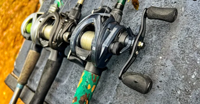 "When should you change your fishing line? As an angler, it’s important to figure out when to change your fishing line. If you don’t change it soon enough, your line could fail in a critical fight with a big fish or while bomb casting a high-dollar lure. If you get in the habit of changing it too early, however, you could cost yourself hundreds if not thousands of extra unnecessary dollars over time.
"When should you change your fishing line? As an angler, it’s important to figure out when to change your fishing line. If you don’t change it soon enough, your line could fail in a critical fight with a big fish or while bomb casting a high-dollar lure. If you get in the habit of changing it too early, however, you could cost yourself hundreds if not thousands of extra unnecessary dollars over time.
There’s an art to knowing when to change your line— and a bit of an art to the actual process of changing out old line for new. You can find some pointers here on how to spool line on a fishing reel. As for knowing when to do this, it depends based on the type of line.
There are three main types of ..." Learn More >> When to Change Your Fishing Line
 Lake of the Woods, LOW Tourism October 17, 2023
Lake of the Woods, LOW Tourism October 17, 2023
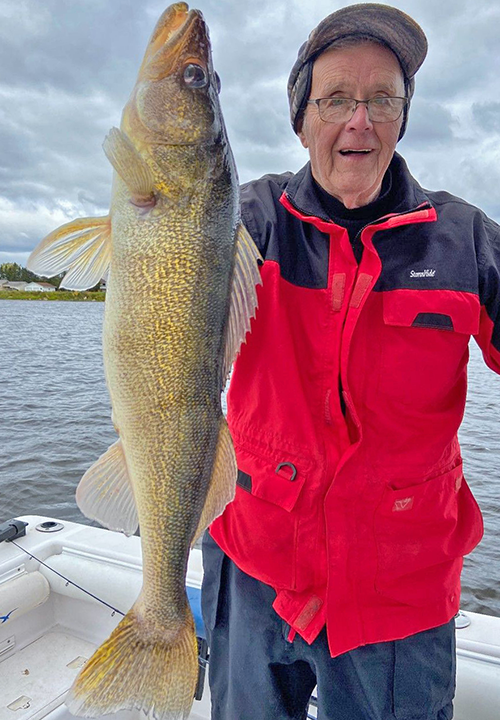 "The waters are getting cooler on the south end of Lake of the Woods and as they fall, the jig bite is picking up. Some great walleye reports this past week from across the lake. Most are focused on walleyes, but the pike, smallmouth bass, jumbo perch and crappies are showing up nicely also.
"The waters are getting cooler on the south end of Lake of the Woods and as they fall, the jig bite is picking up. Some great walleye reports this past week from across the lake. Most are focused on walleyes, but the pike, smallmouth bass, jumbo perch and crappies are showing up nicely also.
There are two main techniques for catching walleyes. Trolling crankbaits and jigging with an emerald shiner are doing very well. Trolling lead core line with crankbaits in 24 to 28 feet of water has been productive. Walleyes are hitting both minnow and shad style crankbaits. Rotate crankbaits with size, color, noise, and trolling speed to get fish dialed in.
Vertical jigging over the side of the boat, either anchored or spot locked, has been doing well. Jig colors of gold, pink, orange, glow white and red or a combo of those colors have been consistent. Various good reports along the south shore which is setting up nicely for early ice fishing season in early to mid-December.
On the Rainy River, shiners continue to run in the Rainy River. Millions of these shiny silver fish continue making their way into the river with walleyes slowly making their way in as well.
Fishing reports have been mixed. Some anglers are getting nice limits of walleyes while others are reporting a lot of small fish with some eaters mixed in. Most are catching a mixed bag including pike, smallmouth bass and crappies.
Two methods are catching most of the walleyes. Trolling crankbaits with lead core line or 3-way rigs to cover water and jigging when fish are more concentrated or swimming through. Good reports in 16 to 24 feet of water.
Up at the Northwest Angle, walleye fishing continues to be very good on both sides of the border. Walleyes are being caught on points, reefs, flats and neck down areas with current in 17 to 22 feet. They are being caught jigging primarily, but those casting or trolling crankbaits are doing well too. The colder water has the pike, smallmouth bass, jumbo perch, crappies and muskies all fired up as well. Ice is just around the corner!" — Lake of the Woods Tourism, (800) 382-FISH
 October 16, 2023 "We Found Crappies, But How Can We Make Em Bite?"
October 16, 2023 "We Found Crappies, But How Can We Make Em Bite?"
Q) "Jeff, We experienced exactly what you said about the crappies being scattered instead of grouping this last weekend. The difficulty we faced was we couldn't get them to bite. We used jigs with minnows and plastics of varying sizes, but the fish were very tight lipped on Sunday.
My conclusion was that maybe we were just trying to fish too soon after the cold fronts. Am I wrong in thinking that the fish just need time to acclimate to the different temperatures and depths before they decide to eat? We know the bite can be extremely light and prepare our equipment accordingly.
Another observation we made was the screen of our graph showing what looks like either plankton or thermocline from 12 to 22 feet of water on the windward side of one area of the lake. The screen was nearly full of dots with no varying features within it. We tried fishing in the area and had no success. Do you have any thoughts about this?
Thanks for your timely, crappie article, we are always trying to learn and adapt to the seasonal changes.
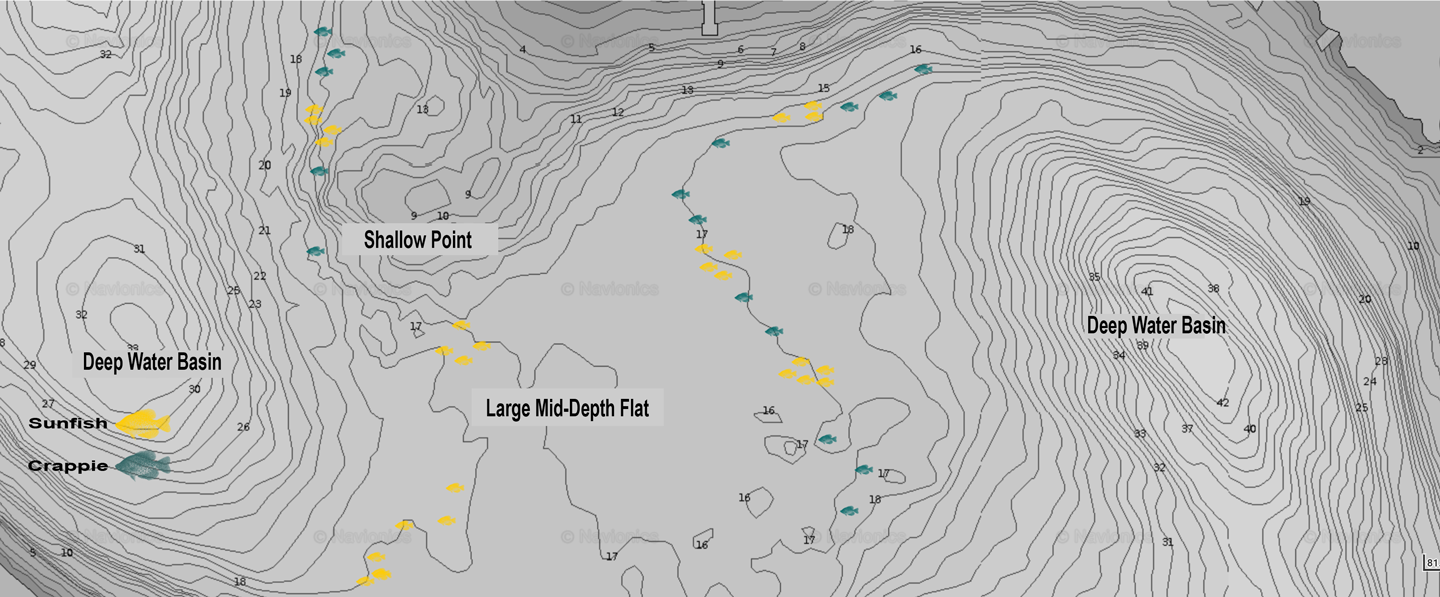 A) As it happens, I and my crew experienced something similar on Saturday. Like you, we tried trolling, vertical jigging, drifting, and so on. of my tricks worked on the some of the fish, but some of them didn't work on any of them. So, I feel your frustration about seeing fish on the graph and trying to "make them bite" when they are not in the feeding mood.
A) As it happens, I and my crew experienced something similar on Saturday. Like you, we tried trolling, vertical jigging, drifting, and so on. of my tricks worked on the some of the fish, but some of them didn't work on any of them. So, I feel your frustration about seeing fish on the graph and trying to "make them bite" when they are not in the feeding mood.
Most occasions that I've ever encountered the phenomenon of panfish spreading out horizontally across the flats is shortly after one of these sharp drops in water temperature. Almost always, the results are similar, I spot several fish on my graph that don’t bite before anybody in my boat gets a strike. I can’t say the ratio is always the same but let’s just say that I have 10 sightings for each fish caught. So, on days like these, I go into the game knowing that I will be working harder and smarter, for less fish. Because of that, there are a few things that I take into consideration before I put my boat in the water.
When I have control of our destination, the first thing I think about is how many crappies are in the lake? If I need to find 10 fish to get 1 strike, then I better pick a lake that has a lot of crappies in it. That’s what I did when I fished with Bugs and Dana earlier this month. On Saturday, I didn’t select the lake, my crew wanted to fish there so I needed to settle for whatever the lake would give us. I’m sure that you have good reasons for fishing on the lake(s) you tried last weekend. But if you have a choice, researching the crappie populations of lakes in your area could be extremely helpful.
My 2nd consideration is the lake’s size and depth, the more water I can cover, the more chance I have of locating the right fish. I love to fish on simple, small lakes during fall. This by the way, is one of the reasons I travel to so many lakes every fall, I never feel like any of them can withstand more than a visit or two each year. Playing the role of explorer might seem risky, but during fall, your chances of locating fish that will bite is good. I figure 1 of 3 “new” lakes typically works out great, the 2nd one might turn out so-so, and the 3rd one will be a bust.
A 3rd consideration is how many fish species are available in each lake. I don’t know about the lake where you were fishing, so I can’t say that you had the option. But I do know that sometimes, anglers mistake seeing sunfish on their graph for crappies. When anyone in my crew gets light strikes, ones that pop and pick at their crappie lures, I always drop a sunfish bait over the side.
The accompanying map is of the actual spot we were fishing on Saturday. On that flat, we had both crappies (marked green) and sunfish (marked yellow) spread out on the same flat. By fishing for both at the same time, we were able to get a little more action and added some tasty fillets to the larder.
Timing your trip is hard to control, but to the extent that you can, be sure to re-visit that lake after the fish have had time to settle into their new climate. Once the ecosystem stabilizes, the crappies will begin to gather, forming larger and tighter schools. Who knows, there might be a hot bite going on that same lake in a week?
I know I didn’t really give you a “hot tip” for making fish strike; that’s because sometimes, we just can’t. That said, if you set yourself up with a few alternative options, you can turn your day into a fun one, if when you don’t get the “expected” results. Be willing to work harder, work smarter, and to settle for less, this philosophy will never let you down. ![]() — Office Cell Call or Text 218-245-9858 or EMAIL
— Office Cell Call or Text 218-245-9858 or EMAIL
 Jeff Sundin October 13, 2023 "Crappies: Dive Deep and Spread Out Pattern"
Jeff Sundin October 13, 2023 "Crappies: Dive Deep and Spread Out Pattern"
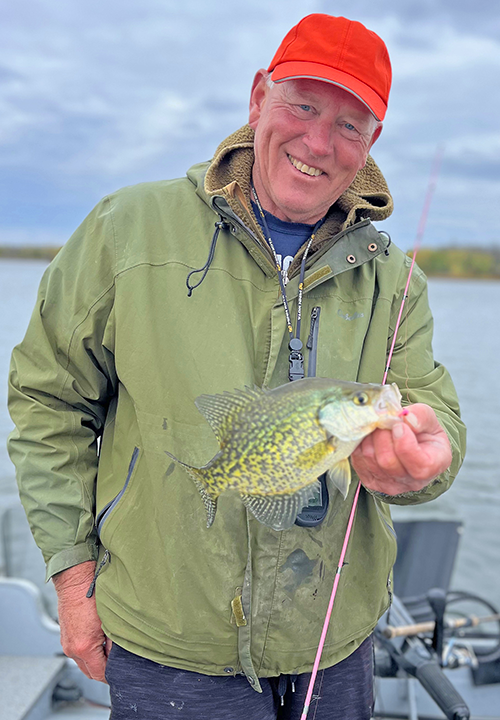 Crappies are always on my mind during the fall, it’s one of my favorite fish to catch. Over the past few seasons, I’ve learned a lot of lakes that fit a profile that I like. They are relatively shallow waters, most of them are shallower than 25 feet, so I’m never tempted to fish for crappies in deep water where barotrauma is a problem. All these lakes also have huge populations of fish that came from a fabulous hatch that occurred sometime in 2016 or 2017. I’ve been following this strong year-class of crappies since 2018 when I first started writing about it.
Crappies are always on my mind during the fall, it’s one of my favorite fish to catch. Over the past few seasons, I’ve learned a lot of lakes that fit a profile that I like. They are relatively shallow waters, most of them are shallower than 25 feet, so I’m never tempted to fish for crappies in deep water where barotrauma is a problem. All these lakes also have huge populations of fish that came from a fabulous hatch that occurred sometime in 2016 or 2017. I’ve been following this strong year-class of crappies since 2018 when I first started writing about it.
Slowly but surely, those small fish have been growing and this is the fall, the one when there are finally good numbers of fish in the 10-to-11-inch, “keeper” range. They’re still not huge by anybody’s standards, but on most days, I can sort out a good limit or two for my customers. This week, I’ve fished for crappies a few times, on a few lakes, and they’ve all been fun.
Caused by the recent hard frost, surface water temperatures dropped hard and fast. On some lakes, the drop was almost 10 degrees over a 4-day period, from 65 degrees, down to 55 degrees on the lake we fished this Wednesday. Crappies on that lake responded by migrating away from the shoreline, and into open water. You might be thinking, DUH, that’s no big surprise, everybody anticipates panfish moving out to deep, open water holes during fall and winter.
There was one other boatful of anglers on that lake who got that part right, what they overlooked though, could surprise some of you.
The anglers I’m describing followed the usual fall protocol, moving around the lake, scanning for schools of crappies that were banded tightly together. The coxswain steered the boat in snake-like curves and swirls, watching his graph like a hawk. He drove the boat slowly at first, then faster, then to the east, then to the south, then west and finally back north. Eventually, he either finally located one school of fish, or gave up the search. Either way, he stopped the boat and anchored, they stayed at that single location for over 3 hours. The whole time they were there, we could see them, and if they were catching crappies, they were really sneaky, preventing any fish from crossing our line of sight.
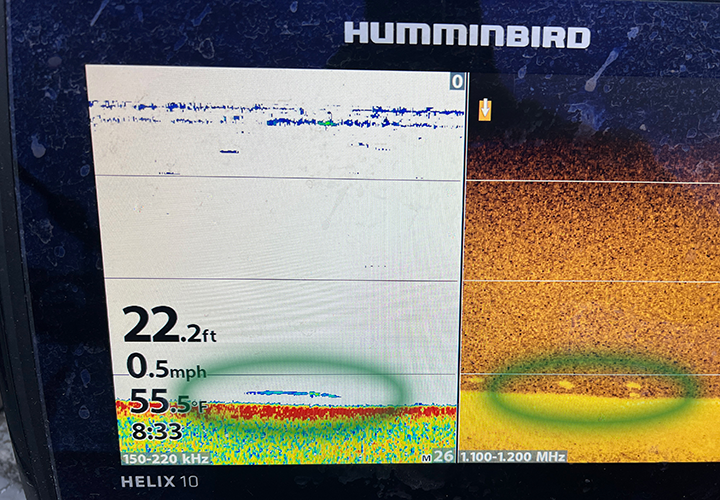 Much of the time, that typical fall protocol that they followed would have worked. Covering water, locating a “stack” of crappies, and then fishing vertically over the school of fish to catch them. What I learned a while back, is also what I hope that other group of fishermen will learn today, from this report. Whenever there’s a sudden, sharp drop in water temperatures, crappies don’t necessarily form those Christmas tree shaped stacks immediately. No, sometimes they do the complete opposite, they sink to the bottom and scatter across the flats horizontally. I don't believe that those fellas never realized that they were driving across dozens of crappies while they searched for one of the traditional, tightly formed schools.
Much of the time, that typical fall protocol that they followed would have worked. Covering water, locating a “stack” of crappies, and then fishing vertically over the school of fish to catch them. What I learned a while back, is also what I hope that other group of fishermen will learn today, from this report. Whenever there’s a sudden, sharp drop in water temperatures, crappies don’t necessarily form those Christmas tree shaped stacks immediately. No, sometimes they do the complete opposite, they sink to the bottom and scatter across the flats horizontally. I don't believe that those fellas never realized that they were driving across dozens of crappies while they searched for one of the traditional, tightly formed schools.
The fish you see on the screen (image right) of my graph is a crappie. It was one of hundreds of singles, doubles, and occasional small packs that we saw on Wednesday morning. The fish were related to the shoreline breaks and at first, were in about 20 feet of water. Later in the morning, they remained relatively tight to the breakline, but moved incrementally deeper. By the time Bugs and Dana had 10 fish apiece, I was spying on fish in 24 feet of water and anyplace shallower than that was void of fish.
Instead of of stopping and fishing vertically, covering water, albeit slowly, works better. Just think of it as walleye fishing and use the same "styles" of fishing. Trolling, drifting, casting and retrieving, anything that allows you to cover territory.
Presentations for catching these loosely formed “schools” of crappies is up to you, they are vulnerable to a variety of lures and baits. Spinners, jigs and minnows, live bait rigs and even floating jigs with minnows will all work. For me, slow trolling using jigs and soft plastics is the most fun. On Wednesday, I used a 1/8-ounce Lindy Live Bait Jig tipped with a 3-inch Berkeley Ripple Shad. In 20-24 feet of water, that combination works well, I can adjust my depth by varying the boat speed, or by adjusting my casting distance.
Bugs was surprised by the size of that combination and admittedly, the profile is large compared to many typical crappie lures. That’s part of the point though, the larger lure serves to discourage some of the smallest fish from striking. At the same time, larger fish looking for a full meal are encouraged by the larger size. Because of that, I do tend to miss a lot of strikes, but that’s okay with me, I don’t want to reel in small fish anyway.
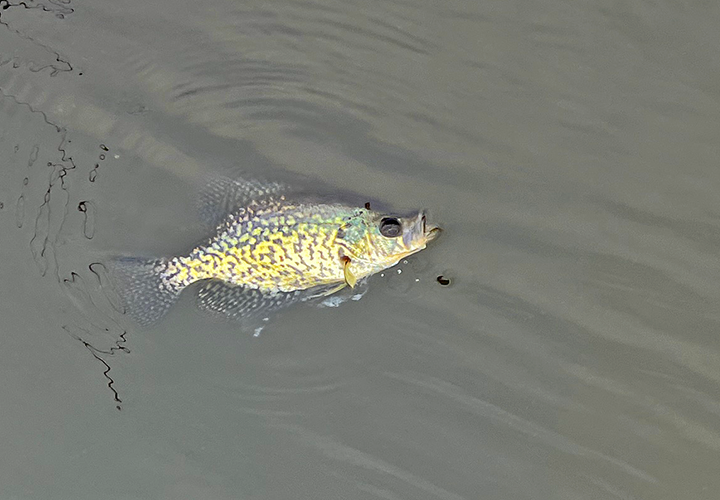 Barotrauma, a phenomenon that we talk about often, is a problem, even in relatively shallow water. Anecdotally, we hear about 30 feet deep being where the problem begins, but that is not always the case. The fish you see floating on the surface (image left) was caught in relatively shallow water; according to my graph, 22.2 feet to be precise. There’s no doubt that catching fish deeper than 30 is worse than catching them at 22 feet, but I believe that the fewer fish we catch in deep water and then attempt to release, the better.
Barotrauma, a phenomenon that we talk about often, is a problem, even in relatively shallow water. Anecdotally, we hear about 30 feet deep being where the problem begins, but that is not always the case. The fish you see floating on the surface (image left) was caught in relatively shallow water; according to my graph, 22.2 feet to be precise. There’s no doubt that catching fish deeper than 30 is worse than catching them at 22 feet, but I believe that the fewer fish we catch in deep water and then attempt to release, the better.
Even though I’ve gone a long way to minimize the effects of barotrauma on fish we catch, there are still times when releasing floating fish becomes necessary. I’m going to share a tip about saving some of those “floaters” from dying. But my advice about releasing crappies caught in deep water comes with this disclaimer. I do not know the exact percentage of the released fish survive. I do know that fish caught in 20 to 25 feet of water typically swim away fast and apparently, unharmed.
On the radio this Thursday, I compared this trick to blowing out the candles at the end of singing the happy birthday song. When you have a “floater”, bring the floating fish into the boat and close to your face, within a few inches. Blow an aggressive, sharp burst of air directly into the fish’s mouth and down its throat. Drop the fish back into the water and 99 percent of the time, it will take off immediately. If it doesn’t appear to work, you’ll need to try again and this time, be more aggressive when you blow; that’s been my experience.
Like I said, I don’t know how many of these released fish survive, so I strongly advise against viewing this trick as a fix up for catching fish in deep water. But it's still better than not doing anything, and if you try it, you will be amazed at how well it works. I like to think that many of the fish will live to have another happy birthday next spring.
Today, I’m back on the search for walleyes, but I’m not sure where. My luck has been good on Winnie lately, but it looks like strong wind my cause problems. I will have the same crew for 2 days, so I might experiment with small water today, then take a swing at Winnie tomorrow. Whatever happens, I’ll let you know. ![]() — Jeff Sundin 218-245-9858 or EMAIL
— Jeff Sundin 218-245-9858 or EMAIL
 Ely Area, Arrowhead Outdoors Fishing Report October 11, 2023
Ely Area, Arrowhead Outdoors Fishing Report October 11, 2023
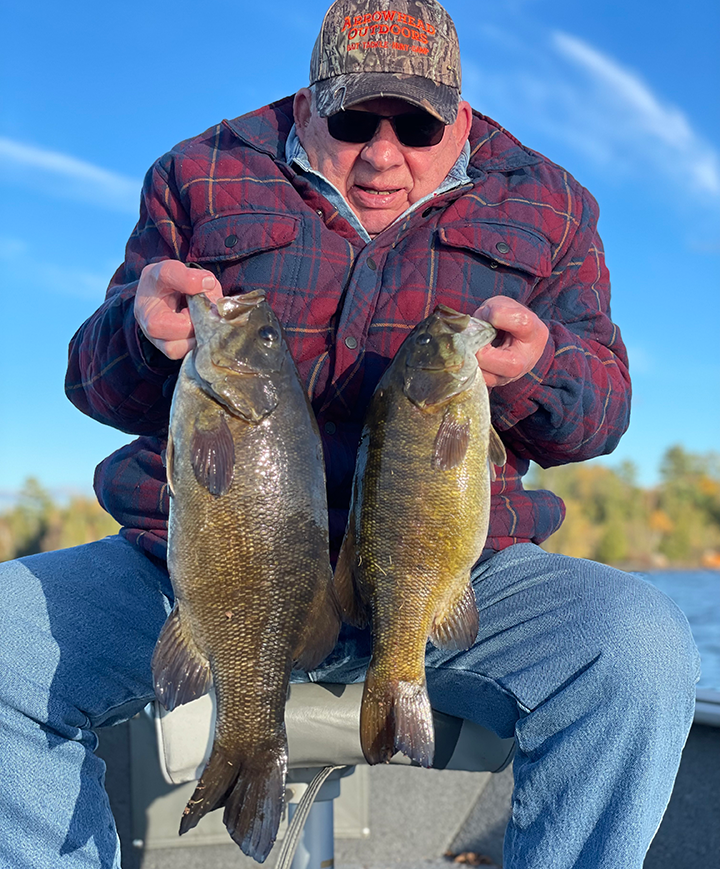 "Walleye anglers continue to report an excellent walleye bite happening on area lakes. Much to many anglers surprise, shallow water continues to the place to find active/aggressive walleyes. 10-15ft has been where the best action is happening. Jig and a minnow or lindy rigs with a big minnow worked along shoreline structure has been best, but sunken islands have also been good.
"Walleye anglers continue to report an excellent walleye bite happening on area lakes. Much to many anglers surprise, shallow water continues to the place to find active/aggressive walleyes. 10-15ft has been where the best action is happening. Jig and a minnow or lindy rigs with a big minnow worked along shoreline structure has been best, but sunken islands have also been good.
Smallmouth Bass have largely set up, out on sunken islands now. Sunken islands that top out in 10-25 feet of water and are close to some of the deepest water in a lake tend to be the best humps for smallies. Large minnows fished on a lindy rig and worked around the sunken island has been very effective.
Stream trout has been a popular choice for anglers as stream trout activity increases as water temps cool off. Shore fishing has become a popular choice as trout come close to shore. Shallow gravel flats has been the best areas to find trout. Anglers have been floating a crawler off the bottom or crawler under a bobber for best results." — Arrowhead Outdoors, 218-365-5358
 Lake of the Woods, LOW Tourism October 11, 2023
Lake of the Woods, LOW Tourism October 11, 2023
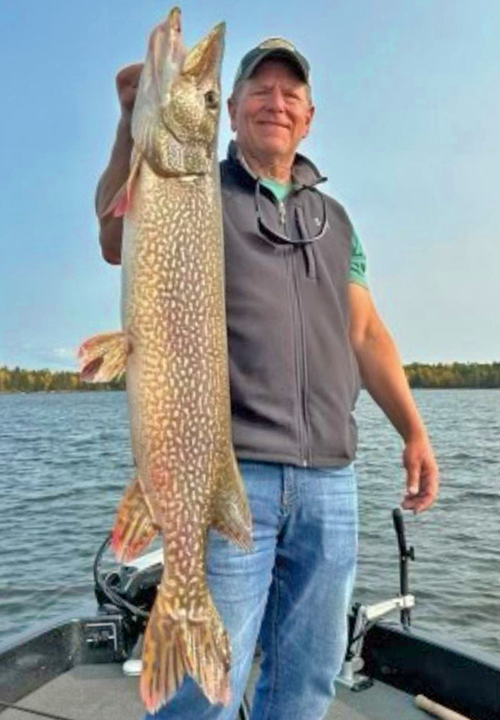 "Fall is a season of transition and walleyes are always on the move. They are in feeding mode, so once you find them, things normally work out. That’s why persistent folks who know how to find them report good numbers of walleyes being caught on the south end of Lake of the Woods! Others, less persistent, tell us that fishing is “just okay”, scratching out limits most reported.
"Fall is a season of transition and walleyes are always on the move. They are in feeding mode, so once you find them, things normally work out. That’s why persistent folks who know how to find them report good numbers of walleyes being caught on the south end of Lake of the Woods! Others, less persistent, tell us that fishing is “just okay”, scratching out limits most reported.
Shiners are running up the river and into some bays. Walleyes are starting to show up in their traditional fall spots, in some cases.
With the unseasonably warm weather, spinners and crankbaits are still working well. Anglers choosing to jig are reporting good action as well. Trolling lead core line with crankbaits between Zippel Bay and Morris Point in 28' has been productive as of late. When these fish get more congregated, jigging will be a fun way to catch them.
A good number of charters are still running north. Pulling spinners and jigging have both produced. A mixed bag for most anglers. Some big crappies are in the mix this year, often over 14 inches. Pike, smallmouth bass, and perch are active as well.
On the Rainy River, shiners continue to run in the Rainy River. Millions of these shiny silver fish are on the move and showing up under lights at the end of resort docks. Fishing reports on the river are mixed, some anglers super happy with nice fish, others reporting catching a lot of small fish. The heavy run hasn't happened yet and fish are moving through chasing shiners. The anticipation is that fishing will only get better as October plays out, it normally does.
Two methods are catching most of the walleyes. Trolling crankbaits to cover water and jigging when fish are more concentrated or swimming through. Walleyes continue to be caught in Four Mile Bay, around Baudette, the airport and of course, other “go to” spots along the way and upstream as well. So many spots to fish and the fish are usually moving.
Some good sturgeon being caught this week. Many were caught by unsuspecting walleye anglers. As the saying goes, "Ya never know what you will catch on Lake of the Woods and Rainy River." Smallmouth bass have also been active. The river boasts a very nice population of bass that don't receive much attention.
Up at the Northwest Angle, walleye fishing up at the Angle is strong right now. Many anglers slide over the border while others prefer to fish MN waters. Both are good.
A reminder, anglers and boaters are allowed to boat from the U.S. into Canada waters without clearing customs if they don't touch land, a dock, anchor, moor or exchange goods or services. Also, no bait allowed from the U.S. into Canada. Live, dead, frozen, etc. all cannot be transported across. Most use plastics. Another option is to purchase bait once across into Canada.
This time of year, when you find them, it normally goes well. A few guides reporting 100+ fish days for walleyes. Walleyes are hanging out on points, reefs, flats and neck down areas with current in 17 - 22 feet. They are being caught jigging primarily, but those trolling spinners or crankbaits are doing well too. Fall is known as a great season for pike, crappies and muskies. The tradition holds true with good fish being caught." — Lake of the Woods Tourism, (800) 382-FISH
 Jeff Sundin October 10, 2023 "Frost On The Pumpkins"
Jeff Sundin October 10, 2023 "Frost On The Pumpkins"
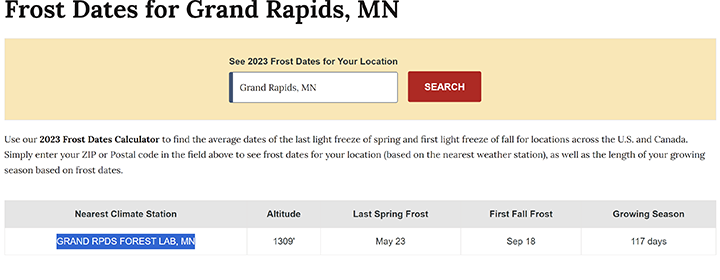 The inevitable first frost of the season settled on the pumpkins at our house on October 9, 2023. For us, it’s the first time ever that frost has not occurred before the end of September. Since the first time I mentioned the “September miss” a few days ago, I’ve heard anecdotal reports from other folks who said that they did observe their first frosts of the season during September. This made me curious, who oversees deciding the “official” first frost day of a season?
The inevitable first frost of the season settled on the pumpkins at our house on October 9, 2023. For us, it’s the first time ever that frost has not occurred before the end of September. Since the first time I mentioned the “September miss” a few days ago, I’ve heard anecdotal reports from other folks who said that they did observe their first frosts of the season during September. This made me curious, who oversees deciding the “official” first frost day of a season?
When I searched the internet for official first frost dates for Minnesota, I got a lot of options to look at but most of them never provided any hard statistics. One of them did though, the Farmer’s Almanac was the only source that provided a table containing dates and they were broken down by city, alphabetically. Feel free to enlighten me about a better source, if there is one, now though, I’ll use the Farmer’s Almanac is effectively the “authority”.
When I checked the frost date for Grand Rapids, MN, TFA references the GRAND RPDS FOREST LAB, MN and lists September 18, 2023, as the official first frost date. I do recall that cold spell and recall too writing about its effects at the time. What I didn’t realize was that it represented the milestone, first frost of 2023 for Grand Rapids.
After the September cold snap, surface water temperatures dropped into the low 60s. Later, they rebounded a little, depending on the lake, settling into the 62-to-65-degree range. After yesterday’s colder, harder frost, surface temperatures took a bigger plunge. At Little Cutfoot Sioux we recorded 53 degrees in shallow water. On Big Cutfoot, we observed 56.5 degrees and over most of Lake Winnie’s north side, 56 to 57 degrees was the observed temperature range.
As of yesterday, walleyes seemed to have shrugged off the colder water temps. I don’t want to make it sound like they were aggressive; the strikes were soft and sluggish. But they were biting, at least enough of them to make a decent day of fishing out of it.
At one stop along the north shore, we found walleyes in 13 to 15 feet of water. At another, we found 11 to 13 feet to be a better depth range for walleyes. Perch were shallower, friends were fishing in 6 to 8 feet of water and found some good ones there. Northern pike were mixed in with the walleyes, striking at random intervals.
Jigs and minnows were the only baits we used, 1/8-ounce weights in calm spots, ¼ ounce where there was more wind. Glow-Blue, Glow-Pink and Glow-Perch were the only colors we used, and all of them worked. Boat speed was important, up to .6 MPH, we could actually hook fish. Anything faster than that resulted in more misses than hits, the fish were not aggressive enough to stick with the lures long enough to inhale the baits. Sometimes we’d hook them, but they’d come off the lines, and many would drop them altogether before we could get the hook set. Still, we did manage to boat a 2-man limit of keepers for the crew, we were satisfied with that.
Today I’ll be back out there with a fresh crew, hopefully picking up where we left off yesterday. I’ll update you tomorrow with any new news that comes from our trip. ![]() — Jeff Sundin 218-245-9858 or EMAIL
— Jeff Sundin 218-245-9858 or EMAIL
 Jeff Sundin October 9, 2023 "How To Babysit A Grandma"
Jeff Sundin October 9, 2023 "How To Babysit A Grandma"
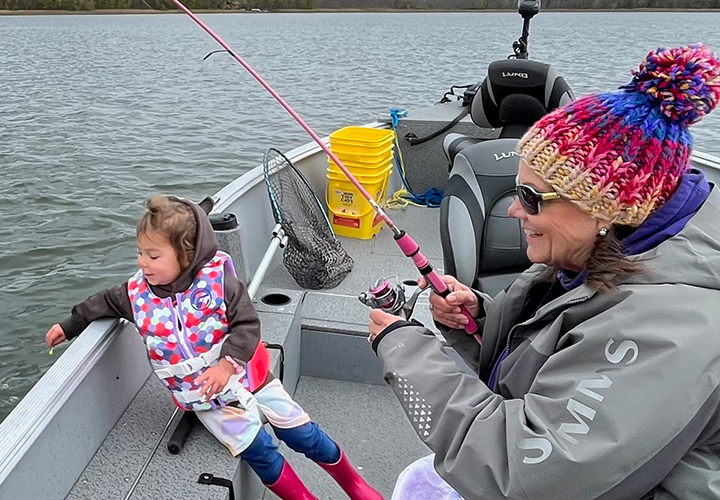 I didn’t really know that I’d be reporting about crappie fishing this morning. In fact, whenever I woke up on Sunday morning, I had no idea that I’d be going fishing at all. That’s because we were enjoying a 3-day visit by our granddaughter and for the past several days, the weather had been anything but inviting.
I didn’t really know that I’d be reporting about crappie fishing this morning. In fact, whenever I woke up on Sunday morning, I had no idea that I’d be going fishing at all. That’s because we were enjoying a 3-day visit by our granddaughter and for the past several days, the weather had been anything but inviting.
Hosting a fishing trip with any 2-year-old requires more than just planning, you also need good weather, good timing too. So, even if we had planned to spend time on the lake, the weather could have easily shut that plan down. Apparently though, our 2-year-old granddaughter Charlotte (“Charlie”) has an inside track on both good luck and good timing.
During the early hours of morning, I was outside changing minnow water, cleaning up the boat and doing a little gardening. While I was doing that, I kept thinking about how nice it was, the wind had stopped blowing, and the sun was out, and I started getting ideas. On one trip into the house, I mentioned to the Hippie Chick that we could, if we were in the mood, go fishing. She mentioned it to Charlie who eagerly said yes, and without hesitation, grandpa began preparing “a plan”.
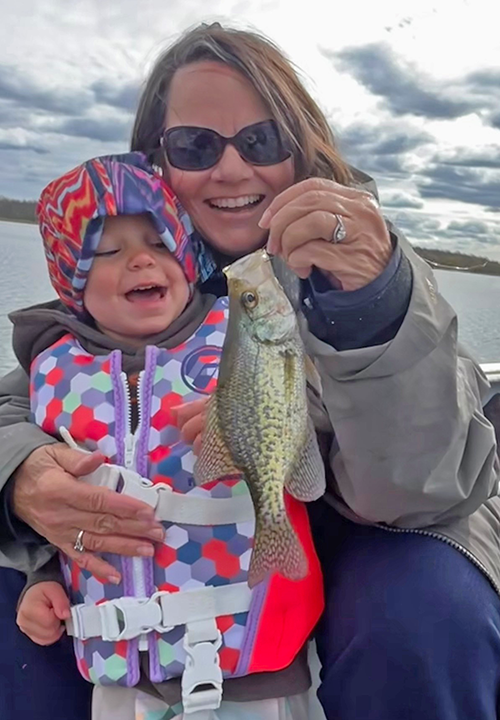 Crappie fishing, on a popular panfish lake close to home, should both give us a chance at catching something, but also provide an easy escape if the trip didn’t go smoothly. When we arrived at the lake, there was a 3-vehicle waiting line ahead of us, and the parking lot had another 10 rigs already parked. Either we were in the right place, or we weren’t the only folks with an itch to get outside; as it happened, it was a combination of both.
Crappie fishing, on a popular panfish lake close to home, should both give us a chance at catching something, but also provide an easy escape if the trip didn’t go smoothly. When we arrived at the lake, there was a 3-vehicle waiting line ahead of us, and the parking lot had another 10 rigs already parked. Either we were in the right place, or we weren’t the only folks with an itch to get outside; as it happened, it was a combination of both.
At our first stop, I found evidence that any crappie migration into open water was in the earliest stages. The lake’s deepest “hole”, a 22-foot, mid-lake depression turned out to be void of fish. Along the steep breakline though, there were good numbers of fish showing up on the screen. The depth ranged between 16 and 18 feet, and the crappies held tight to it, if I went out to 19 feet, or in to 15 feet, the screen of my graph went blank.
During early fall, my preferred presentation is a jig tipped with soft plastics. I like to either troll or drift along the break, cast the lure out and keep it moving with a “sweep-drop-sweep” motion. To an observer, it could look like snap jigging for walleyes, but the motion should be a little smoother than that. The key is to encourage the tail to keep swimming, undulating as you sweep it forward, and as it drops back. Whether you use a paddle tail, a twister tail, or some variation, crappies respond extremely well to the motion. My first lure was a 1/8-ounce live bait jig tipped with a 2-inch twirl tail, and it worked. The problem was most of the fish we caught were small, too small, even for a toddler, so I tried an experiment.
My 2nd lure was the same jig, but tipped with a larger, 3-inch ripple shad. The larger profile seemed to help, I missed a lot of those small fish, but that’s a good problem because it allows the lure to stay in the strike zone longer. Instead of reeling in a ton of 6-to-8-inch fish, I had an opportunity to hook the occasional 10-to-11-inch fish. The Hippie Chick had been using a jig and minnow, and that worked too, but with the plastics turning in a solid performance, her bait got changed too. The 3-inch ripple shads worked even better for her, and she bagged all the largest fish that we caught.
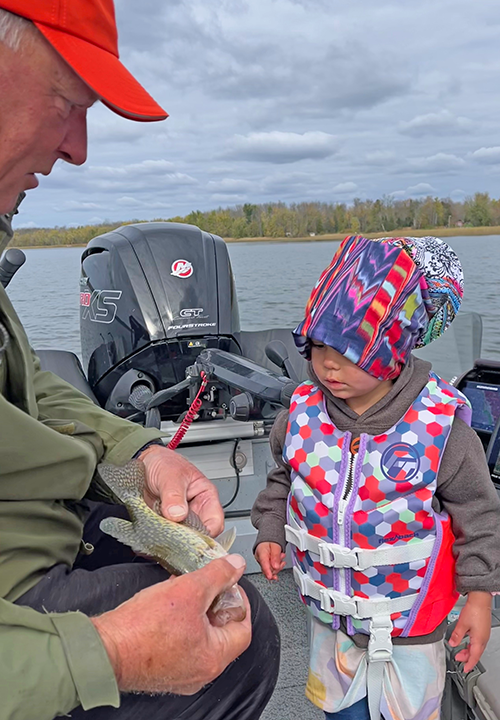 I doubt that most “hard-core” crappie anglers would have been impressed by the fish. We did keep 10 fish, and a couple of them were 12 inches, a couple others were 11 inches, but the rest were 10 inches long on a good day and there were many fish below 8 inches. But from what we saw, there were other folks like us out there, several boats occupied by families with kids. So, size might not have been as important as the combination of action, along with getting enough keepers for a fish fry.
I doubt that most “hard-core” crappie anglers would have been impressed by the fish. We did keep 10 fish, and a couple of them were 12 inches, a couple others were 11 inches, but the rest were 10 inches long on a good day and there were many fish below 8 inches. But from what we saw, there were other folks like us out there, several boats occupied by families with kids. So, size might not have been as important as the combination of action, along with getting enough keepers for a fish fry.
And then there’s Charlie, who had her own axe to grind, getting the Hippie Chick, aka “Nana Suz” out of the house for an afternoon. Just when it seemed like time to head off the lake, she buried herself under a makeshift tent of blankets and went to sleep. What good grandparents would ever wake up a sleeping toddler? Surely, we never would, so naturally, our fishing time was extended a little bit. For me, it was gratifying because I know that my granddaughter is comfortable in the boat, that is a blessing!
Today’s report might not be the biggest fishing news of the month, but could still be useful for you though. If the progression on other lakes is like what we found yesterday, then it may mean searching for crappies closer to shore than what you’re used to at this time of the season. A few years ago, I wrote an article about fall progressions, so instead of re-writing the whole thing, I’ll offer you this link in case you want to dig deeper. Read Article >> Following Out Fall Crappies
Today marks the beginning of another full week of walleye fishing. Depending on the weather, I’ll likely be doing most of it on Cutfoot and Winnie, but I don’t know that for sure. I know that by now, the audience is getting smaller by the day, but for those of you die-hard anglers out there, I’ll keep the reports rolling at full strength for a while. So, please stay in touch and let me know when you have questions. ![]() — Jeff Sundin 218-245-9858 or EMAIL
— Jeff Sundin 218-245-9858 or EMAIL
 Lake of the Woods, LOW Tourism October 4, 2023
Lake of the Woods, LOW Tourism October 4, 2023
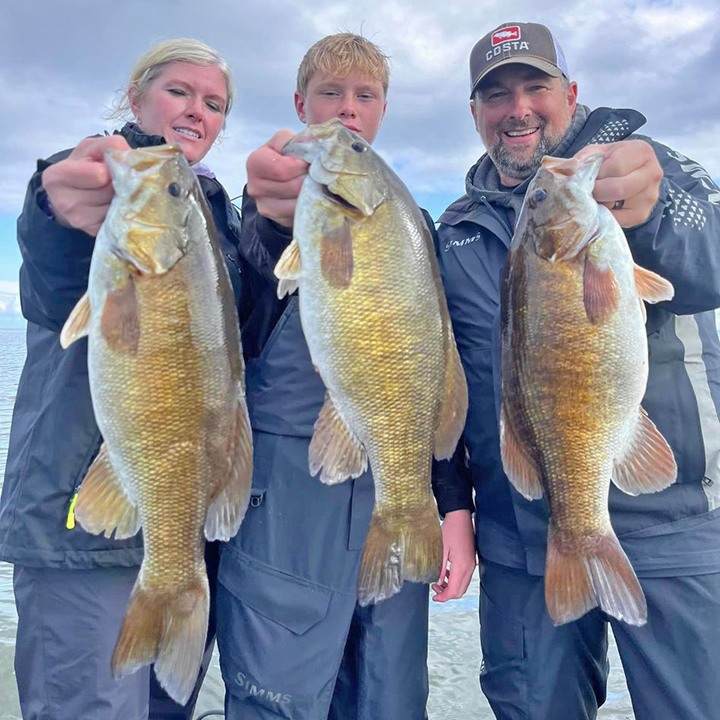 "The calendar says that it's fall walleye fishing time on the south end of Lake of the Woods. However, the weather this past week has felt more like late summer. Water temps are holding, but days are getting shorter which moves things along and fish are being caught. Fishing reports throughout the week have been mixed, some have reported excellent fishing, others say they've simply had "good" fishing.
"The calendar says that it's fall walleye fishing time on the south end of Lake of the Woods. However, the weather this past week has felt more like late summer. Water temps are holding, but days are getting shorter which moves things along and fish are being caught. Fishing reports throughout the week have been mixed, some have reported excellent fishing, others say they've simply had "good" fishing.
Anglers also report catching a mixed bag that includes big pike, jumbo perch, a few crappies and an occasional sturgeon in the mix of walleyes and saugers throughout a day of fishing. Most fish are being caught in 18 to 32 feet of water, depending upon where you are fishing. Don't forget about the morning and evening bite along the shoreline, in shallower areas too.
With the warmer weather, summer patterns like trolling spinners and crankbaits are still working well. Crankbaits in gold, blue/silver, chrome, chartreuse and firetiger are all proven reliable colors. Rotate size, wobble and color until you get dialed in to the presenation walleyes want.
Jigging for walleyes has been productive too, and will likely soon become the dominant presentation. Anglers jigging are reporting gold, pink, glow, orange and chartreuse colored jig tipped with a frozen emerald shiner is hard to beat.
Shiners have begun moving into the Rainy River but the heavy run hasn't happened yet. Fish that are moving through will be chasing whatever schools of shiners they can find. There have been good fishing reports with fish being caught. Every year is different, time will tell on this year's run, when it happens and how heavy the run is.
Much like the lake, various methods are still catching walleyes. Spinners and crankbaits to cover water if you are looking for fish or if fish are spread out. Jigging when fish are more concentrated or swimming through.
Walleyes continue to be caught in Four Mile Bay, along various shoreline breaks, bars and other pieces of structure up and down the river.
Multispecies action on the river. Pike and smallmouth bass along structure on shorelines. Some nice fall sturgeon are being caught up amongst the migration and beauty anchored up and soaking crawlers and or frozen emerald shiners.
Walleye fishing up at the Northwest Angle continues to be good. Some believe when cooler weather sinks in, fishing will get even better. Limits of walleyes are being caught on both sides of the border. Walleyes are hanging out on points, reefs, flats and neck down areas with current. They are being caught jigging, pulling spinners and trolling crankbaits. All three methods are catching fish.
Fall is a great time to fish crappies amongst the islands. Fish in 20 - 30 feet off of points and around brush piles. Muskies continue to be active with some big fish being caught. A mixed bag with pike and smallmouth bass showing up nicely." — Lake of the Woods Tourism, (800) 382-FISH
More Recent Fishing Reports
Lake of the Woods 10-4 • Winnie 10-2 • Crappies 9-30 • Winnibigoshish 9-28 • Ely 9-27 • Sunfish 9-27 • Winnie Weeds 9-26 • Walleye Report 9-25 • Fishing Hall of Fame 9-24 • Sundin 9-18 • Ely MN 9-14 • Crappies 9-12 • Wiggle Worm 8-27 • Forward Sonar • Panfish Workgroup • Follow on Facebook
 Wired2Fish September 2023 "How Fish Finder Technology Impacts Angling with Matt Herren"
Wired2Fish September 2023 "How Fish Finder Technology Impacts Angling with Matt Herren"
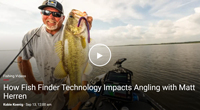 "Pro bass angler Matt Herren is quick to admit that he’s not a fan of all the new technology in fishing. But love it or hate it, he’s also frank about the need to embrace fish finder and boat control tech to remain competitive as a tournament angler. In this broad modern fish finder technology video, Herren discusses several key technologies that have changed how we fish, which equates to finding fish faster and staying on them more efficiently than ever.
"Pro bass angler Matt Herren is quick to admit that he’s not a fan of all the new technology in fishing. But love it or hate it, he’s also frank about the need to embrace fish finder and boat control tech to remain competitive as a tournament angler. In this broad modern fish finder technology video, Herren discusses several key technologies that have changed how we fish, which equates to finding fish faster and staying on them more efficiently than ever.
Delving deeper, Herren showcases the power of Side Imaging and Down Imaging. Once akin to fiction, these tools have become the angler’s underwater eyes, enabling a clear view that drastically reduces the time to locate prime fishing spots when used with ..." View Video and Learn More >> How Fish Finder Technology Impacts Angling with Matt Herren
You Are Invited To Become A Duly Deputized Fishrapper Cub Reporter
 If you've been waiting for a gold engraved invitation to participate in the daily reports, then stop waiting and consider this your own personal invitation.
If you've been waiting for a gold engraved invitation to participate in the daily reports, then stop waiting and consider this your own personal invitation.
Helping your fellow fishermen and women stay abreast of fishing conditions in your area is good for everybody and it's easier than you think! You don't have to write a book, you don't have to share your secret fishing spots and you don't even have to mention your lake. But even a few words about general trends, seasonal patterns and local weather conditions can really help.
Be like me, become a duly deputized "Cub Reporter", it's good for fishing! Contact Us or if you prefer to be "social", Fishing Reports Minnesota, the Facebook counterpart to this page is open to the public, so you can post your own fishing update or just share a photo of a nice catch.